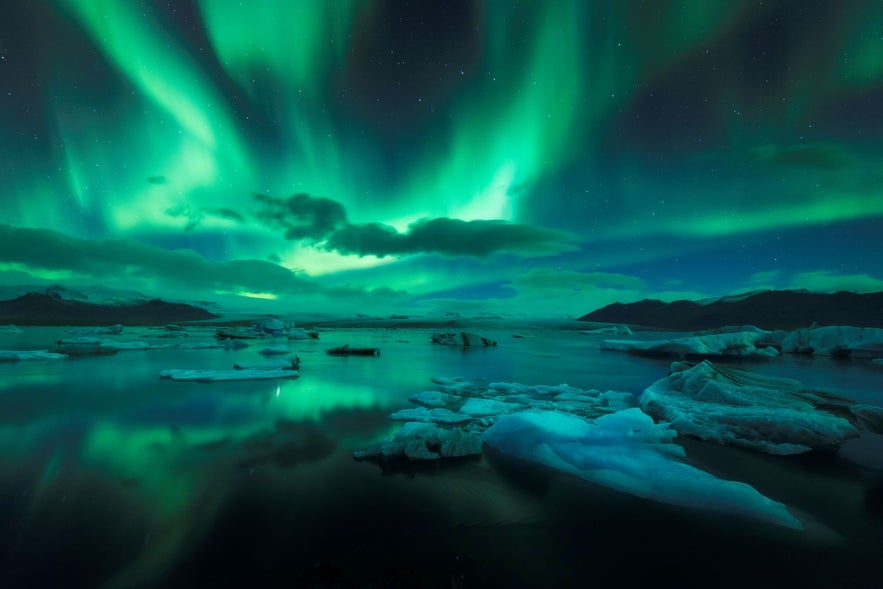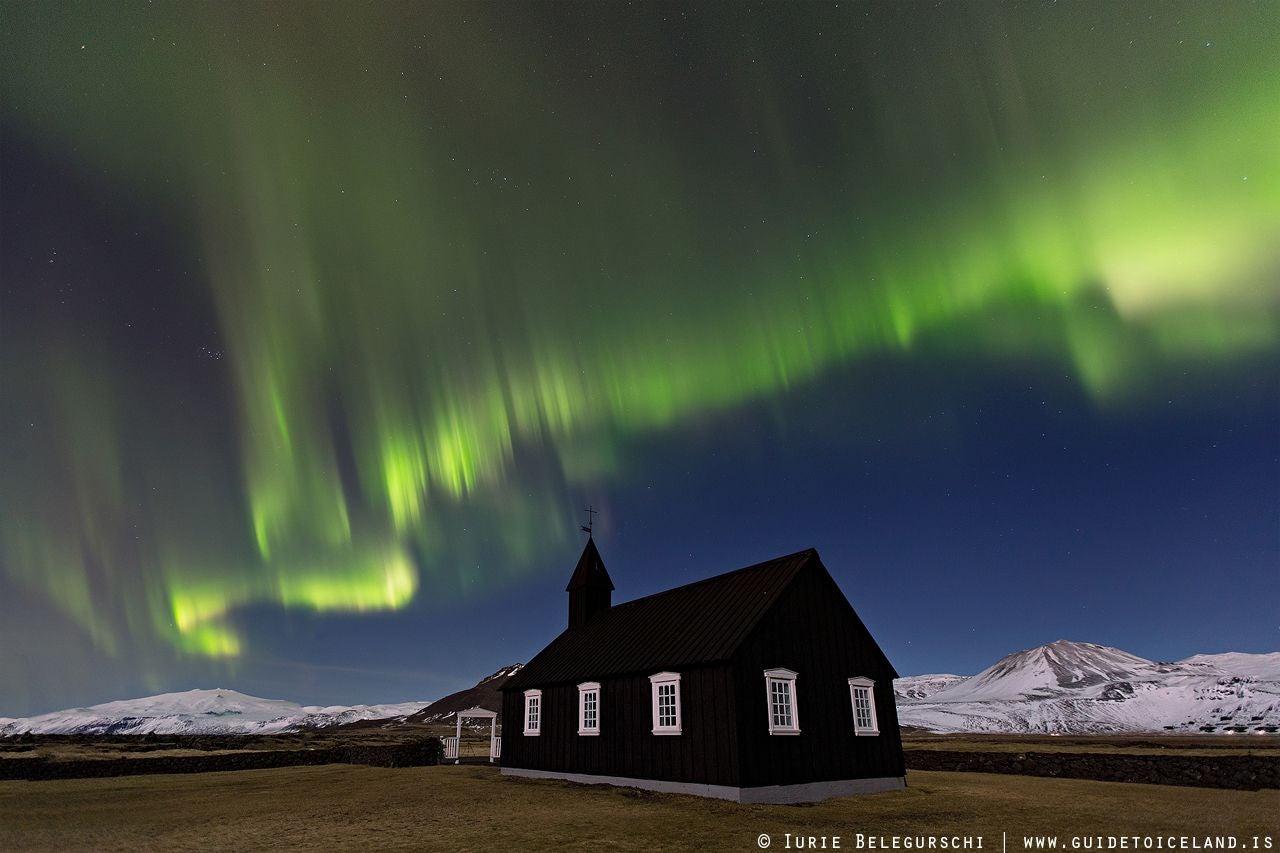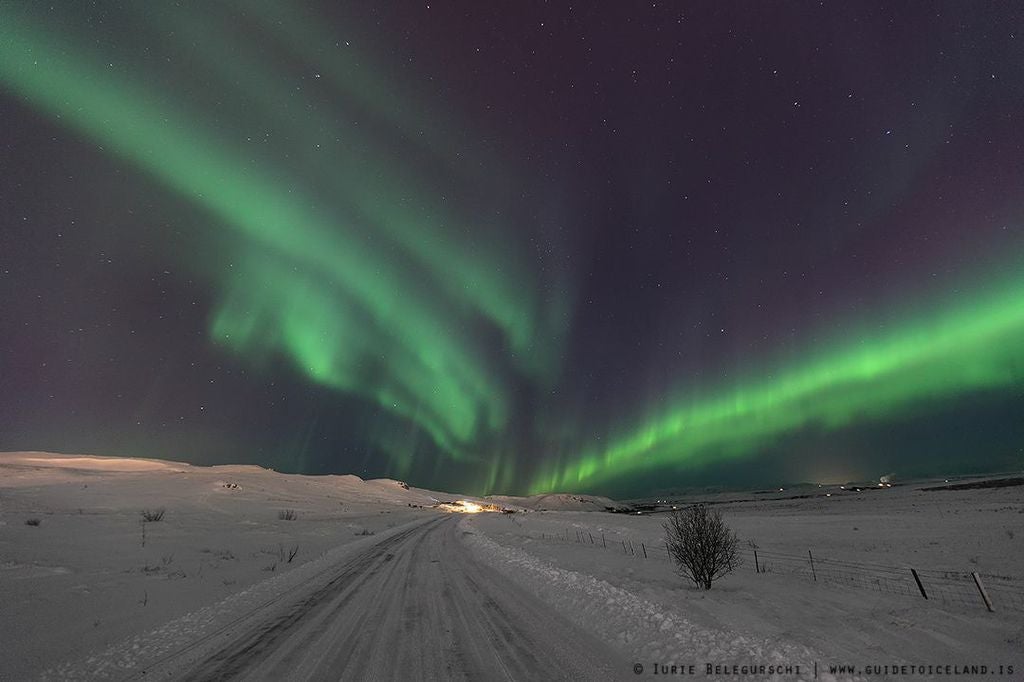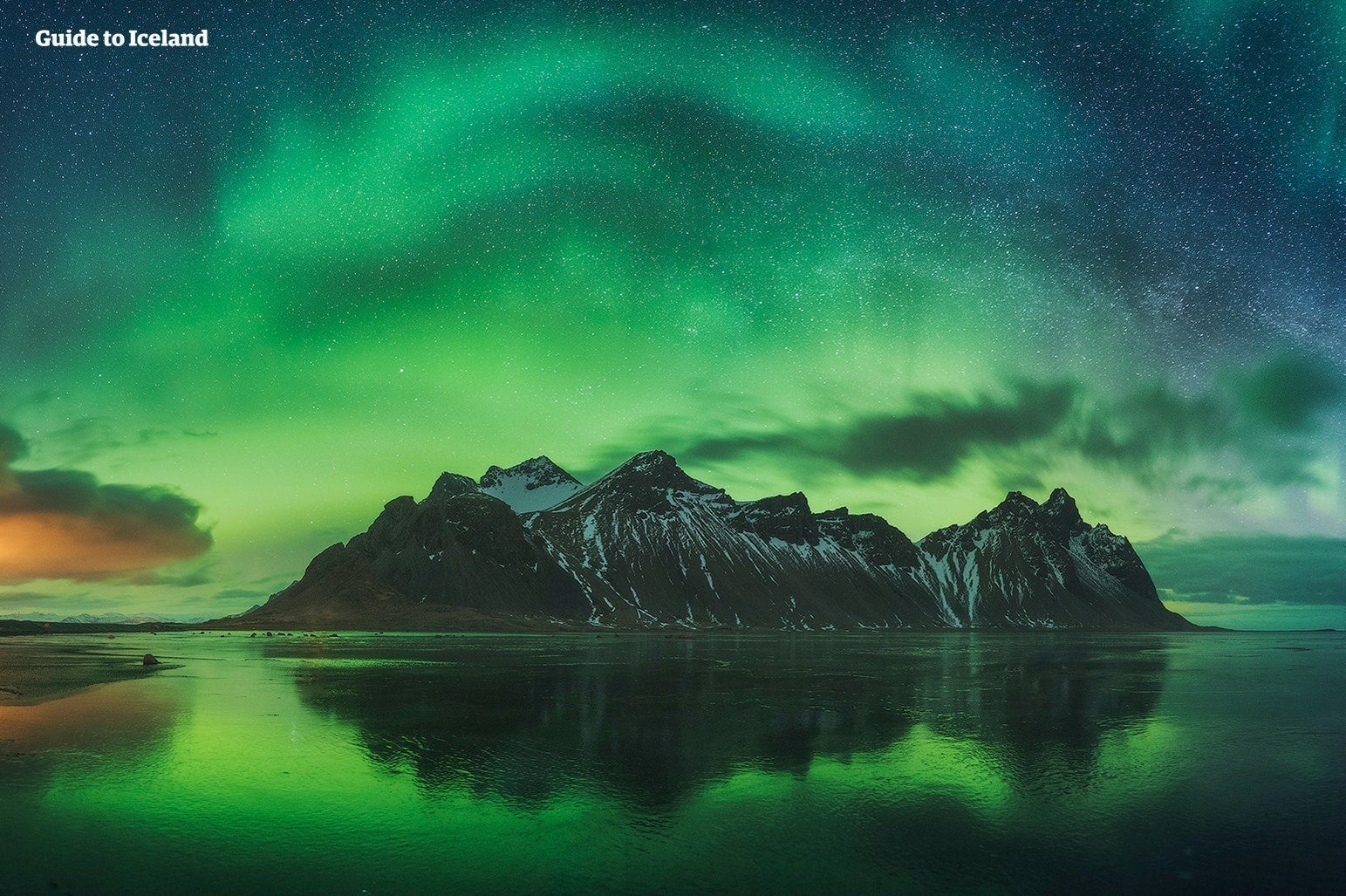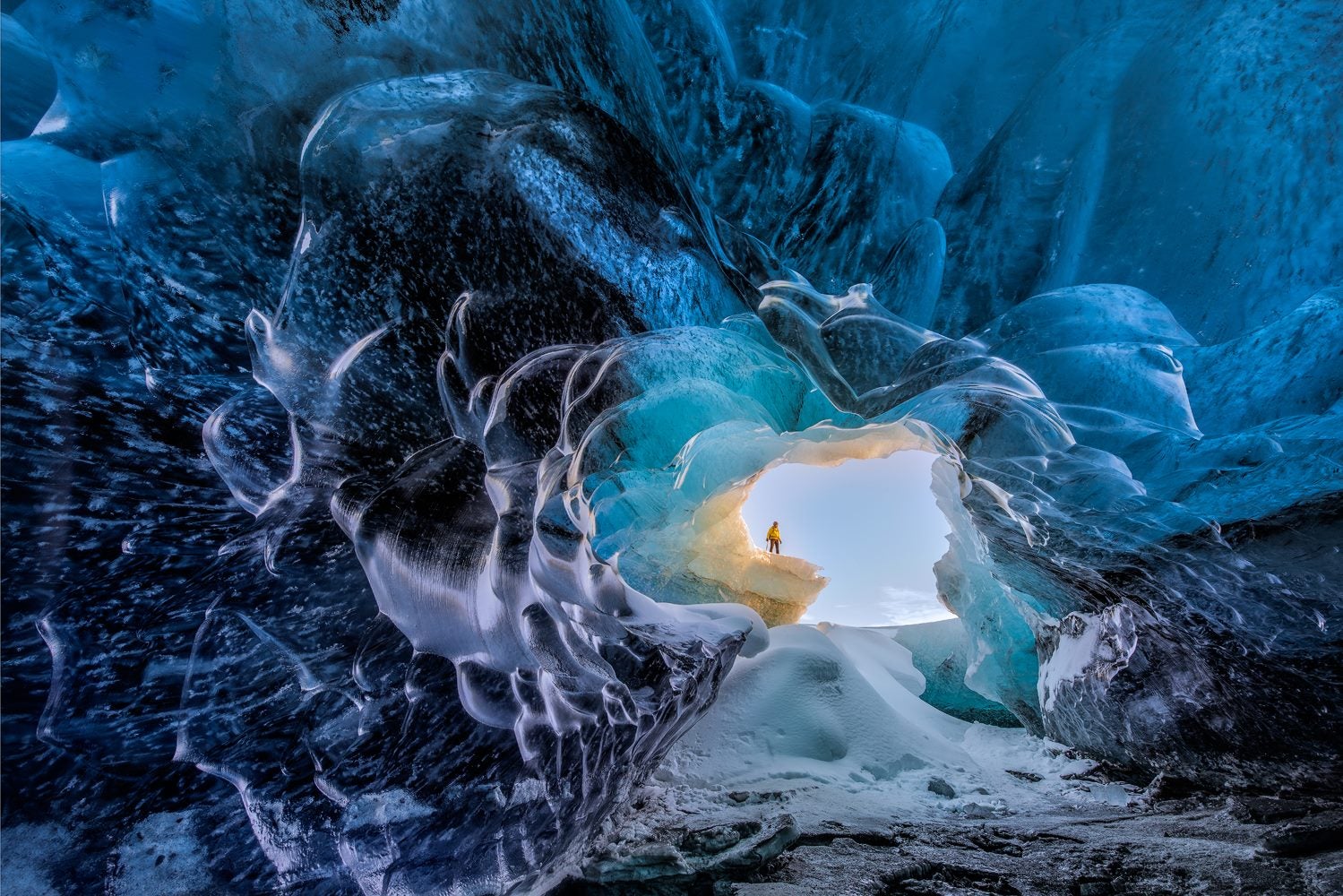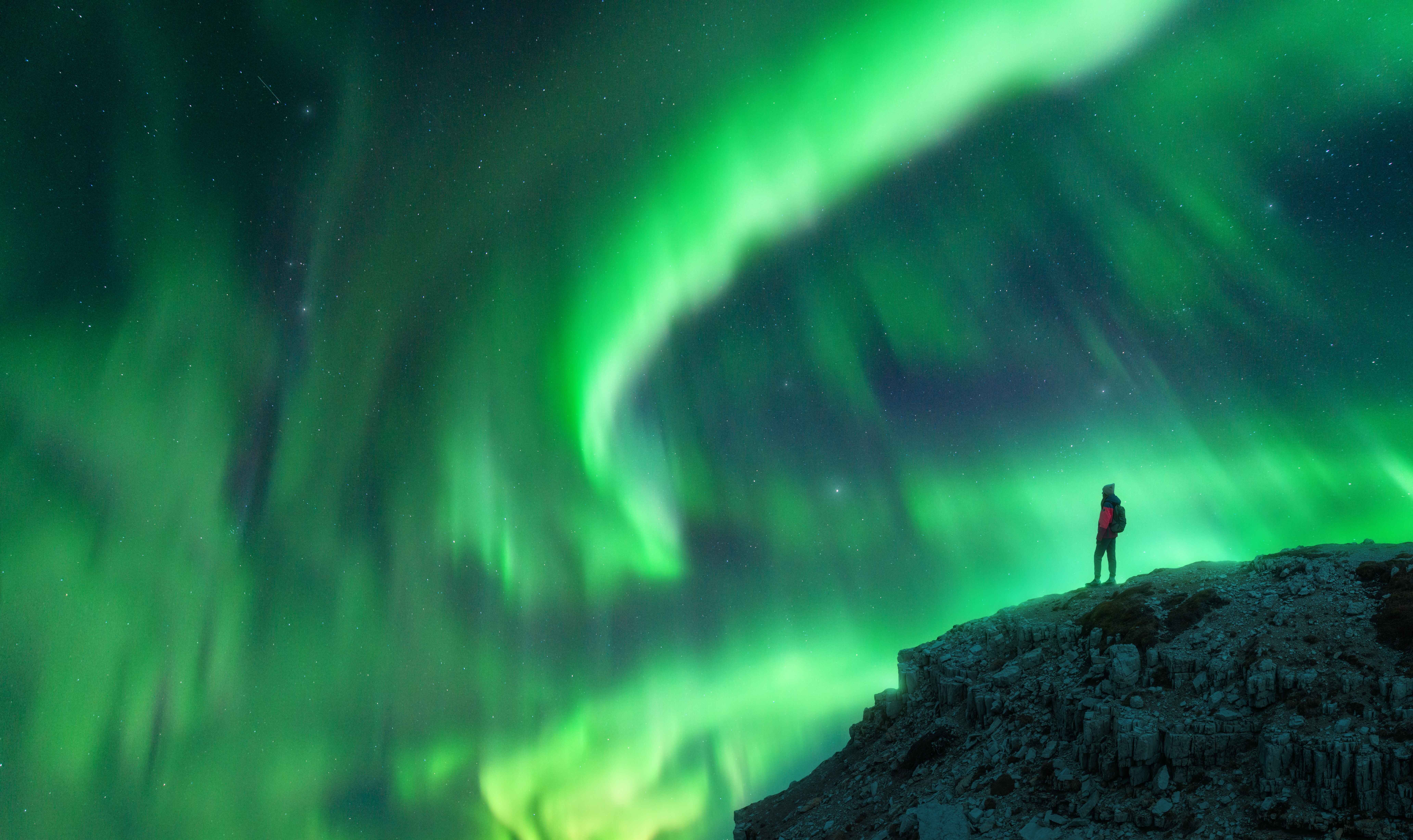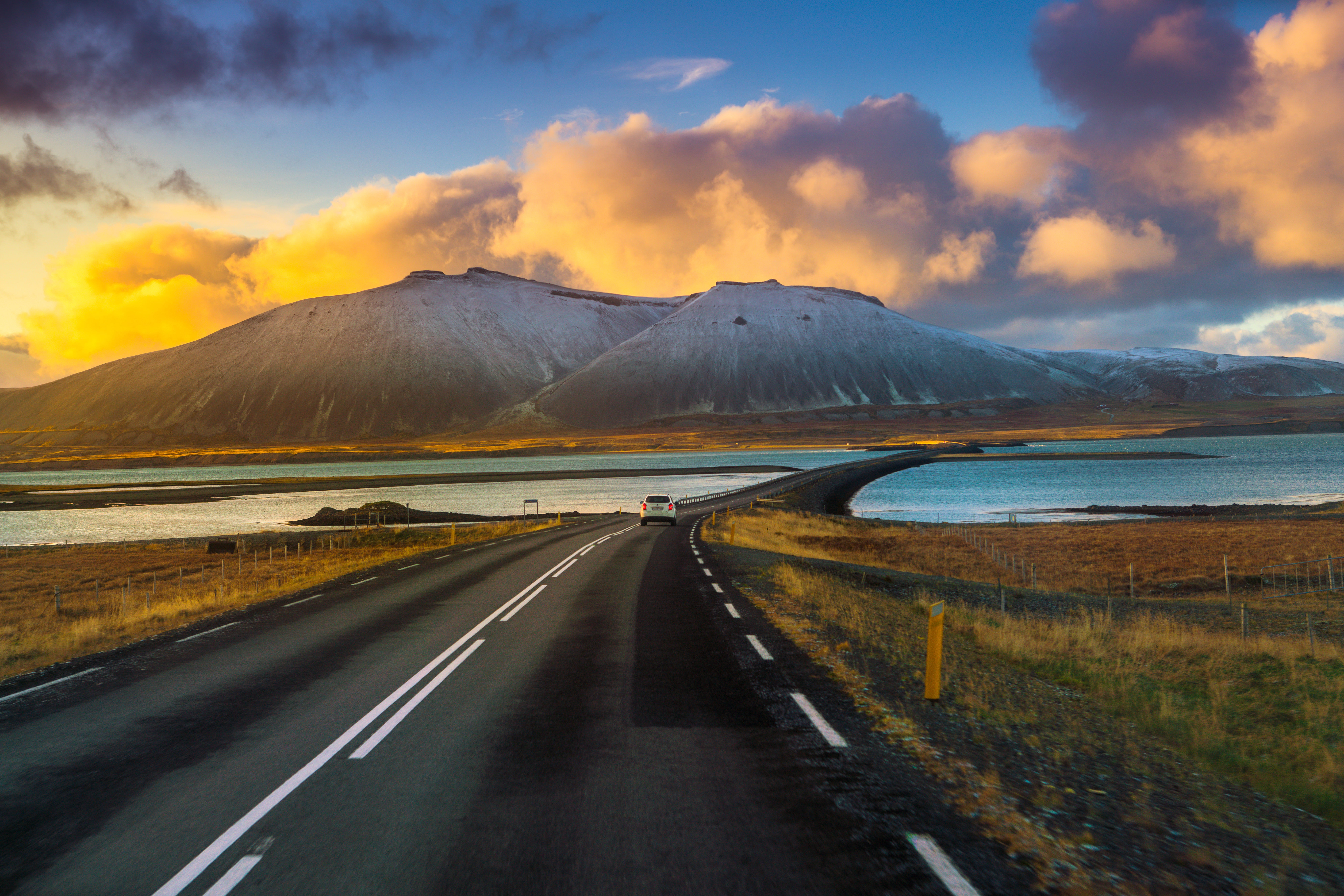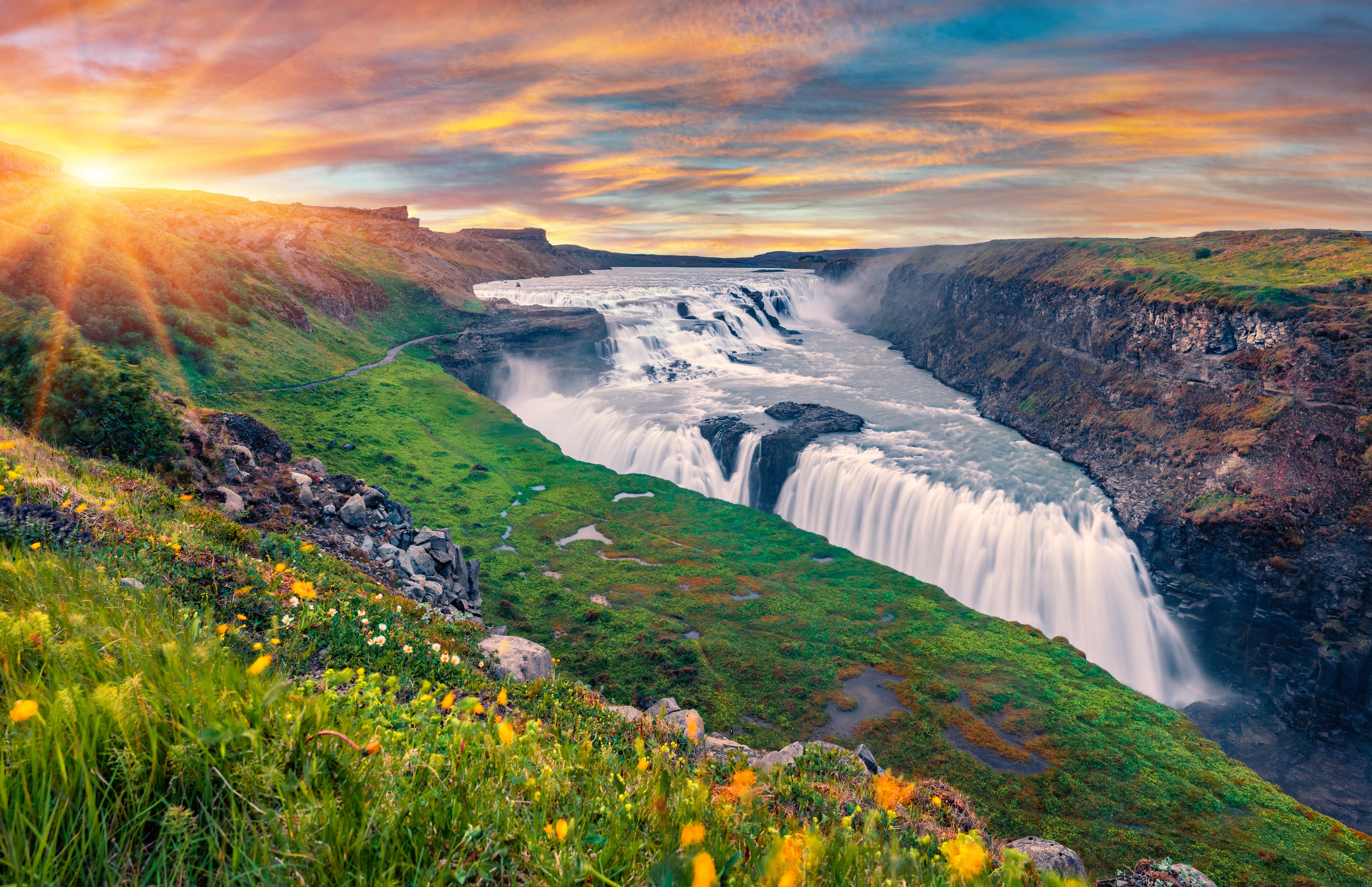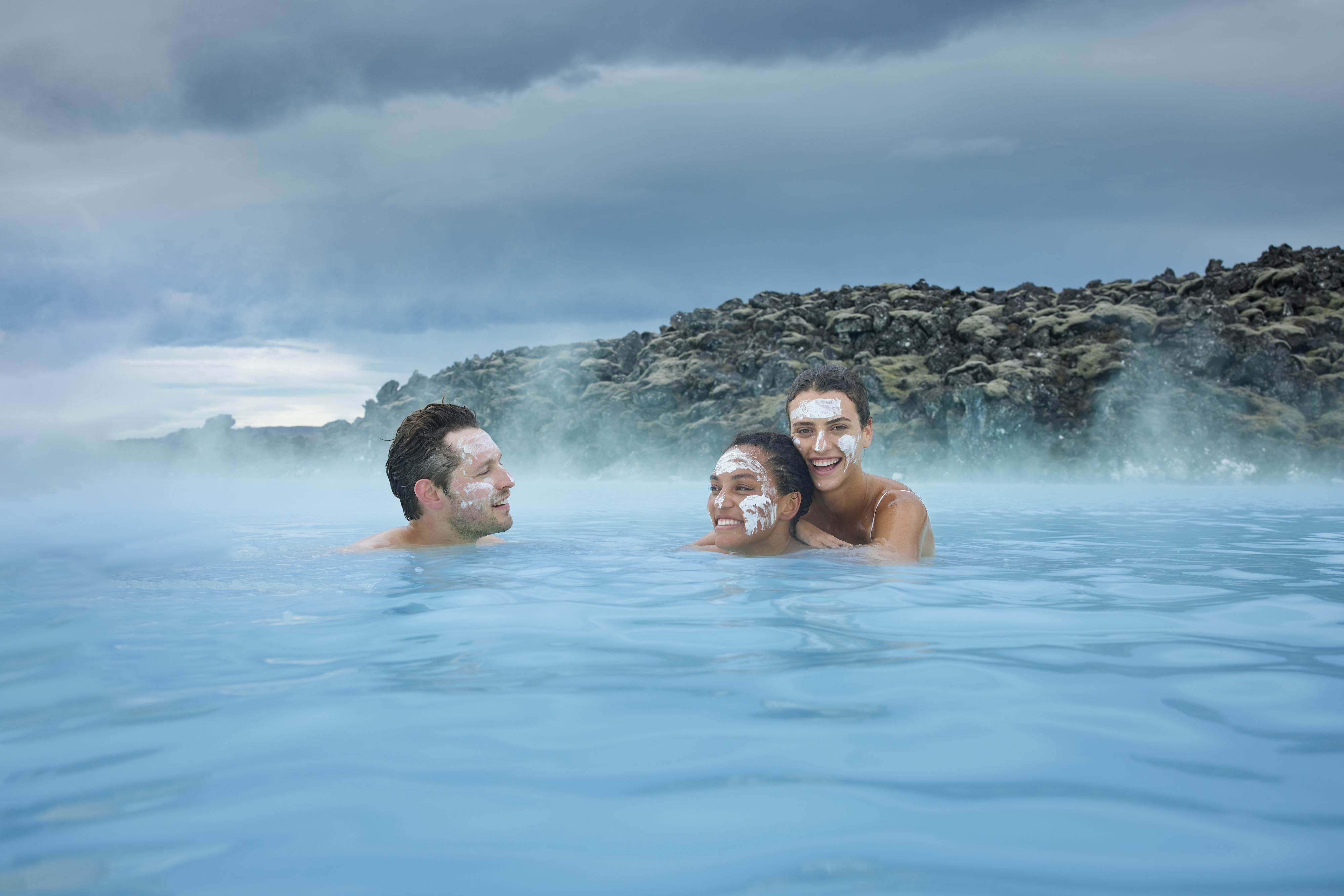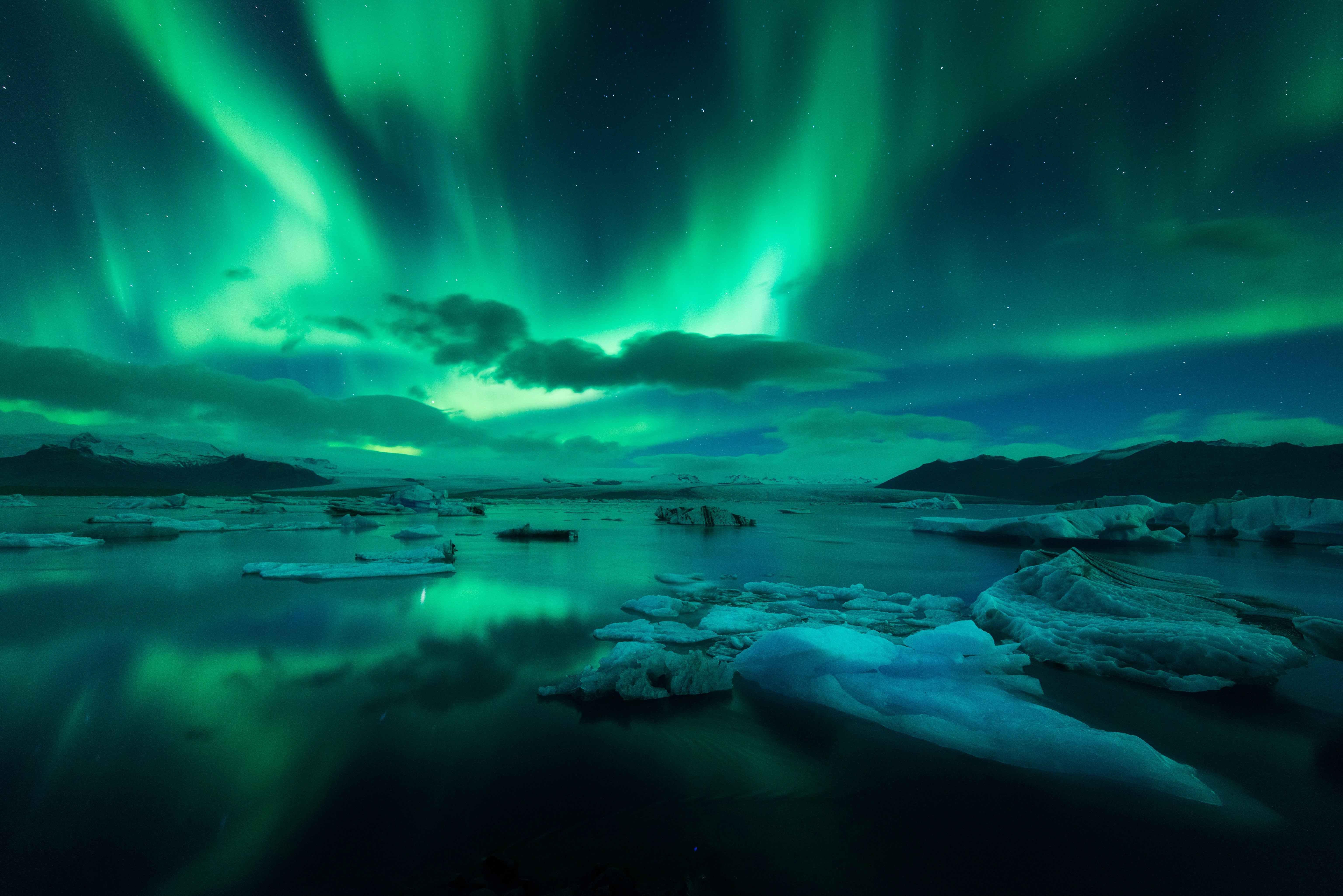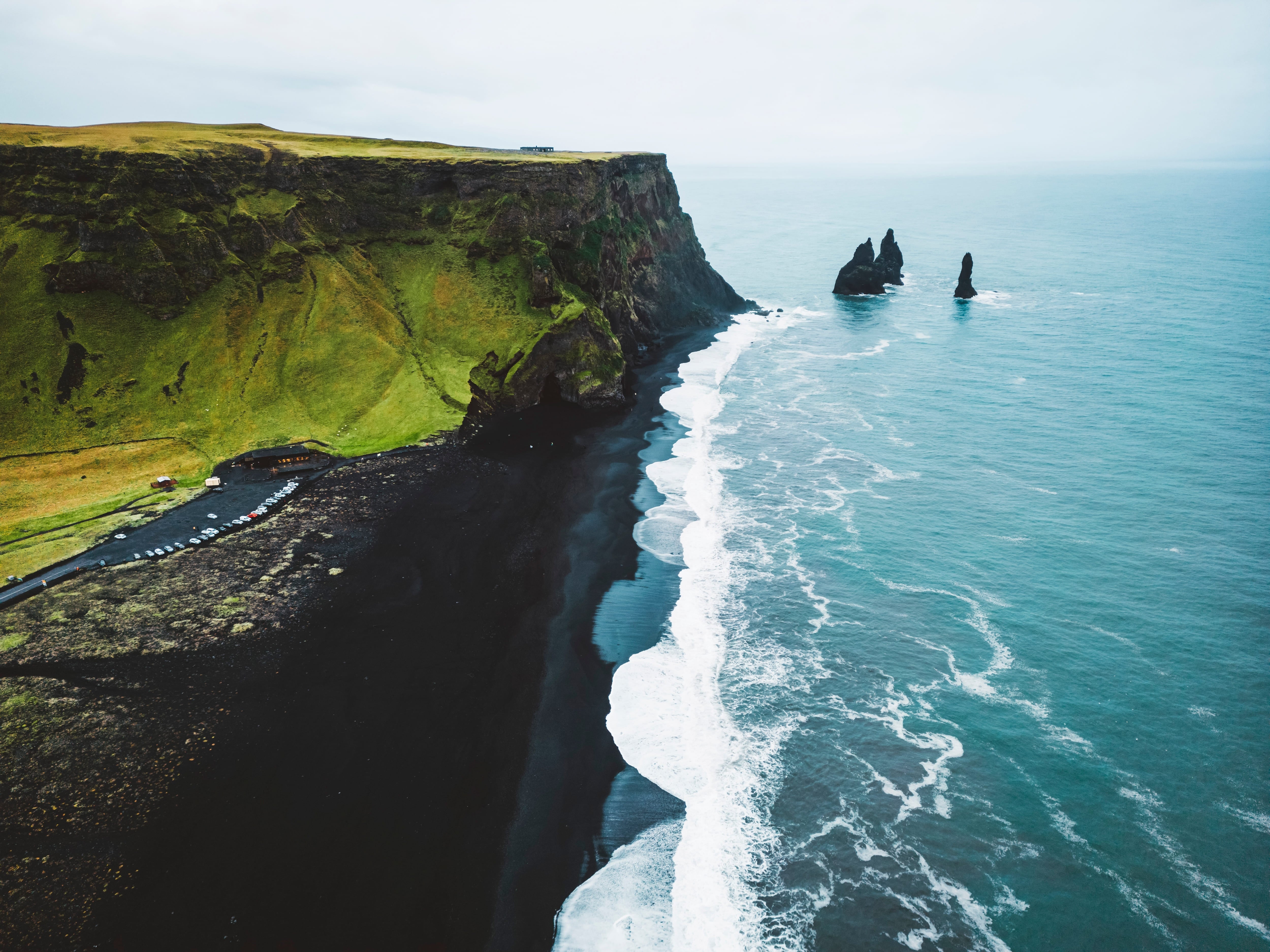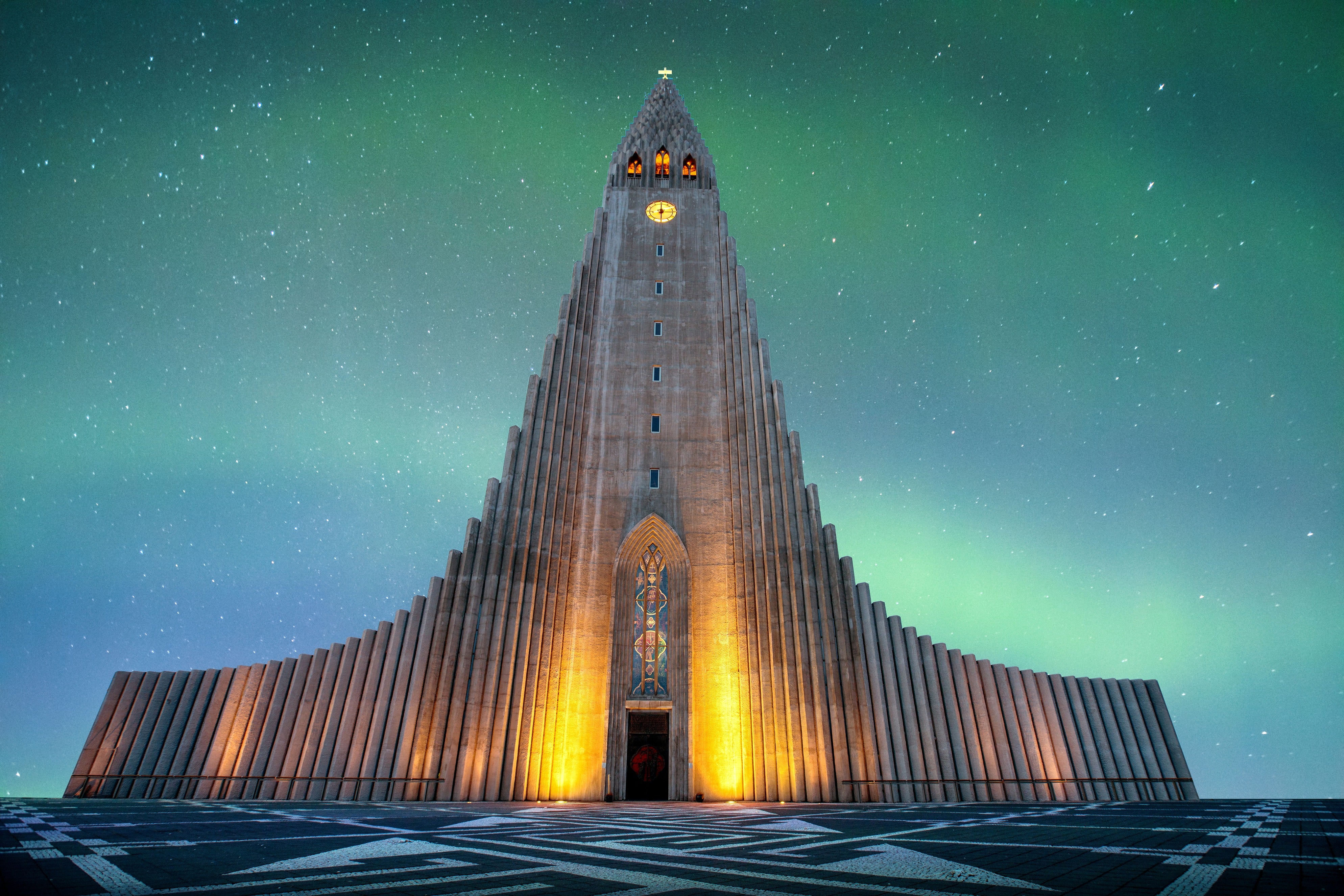
The northern lights are a natural wonder that has fascinated people for centuries and drawn both amateur and professional astronomers to Iceland. Many travelers choose to join northern lights tours to witness the spectacle, while others set out on their own to find the best viewing spots.
If you travel to Iceland in 2025 or 2026, you’ll be visiting during a peak of solar activity. This period is expected to bring brighter and more frequent northern lights displays, making it an especially exciting time to experience the aurora in Reykjavik.
Why You Can Trust Our Content
Guide to Iceland is the most trusted travel platform in Iceland, helping millions of visitors each year. All our content is written and reviewed by local experts who are deeply familiar with Iceland. You can count on us for accurate, up-to-date, and trustworthy travel advice.
Key Takeaways
-
Iceland’s Prime Location: Iceland's location within the Arctic Circle and Reykjavik, the northernmost capital in the world, makes this an ideal location to view the aurora borealis, given the right conditions.
-
Best Places in Reykjavik: Top spots in the city include Grotta Nature Reserve, Perlan Hill, the Sun Voyager Sculpture, Klambratun Park, and the Grandi District, all offering good chances to see the lights with minimal light pollution.
-
Best Viewing Time: The northern lights are typically visible from September to April, with the peak season from November to early March. Midnight is usually the best time, but they can appear anytime between sunset and sunrise.
-
Why 2025 and 2026 Are Special: These years fall during the solar maximum, the peak of the sun’s activity cycle, meaning brighter, stronger, and more frequent aurora displays are expected in Reykjavik and across Iceland.
-
Forecasts and Conditions: Seeing the northern lights requires dark, clear skies and solar activity. Check the Icelandic Meteorological Office's aurora forecast for the best chances, but remember sightings are never guaranteed.
The Best Time to See the Northern Lights in Iceland
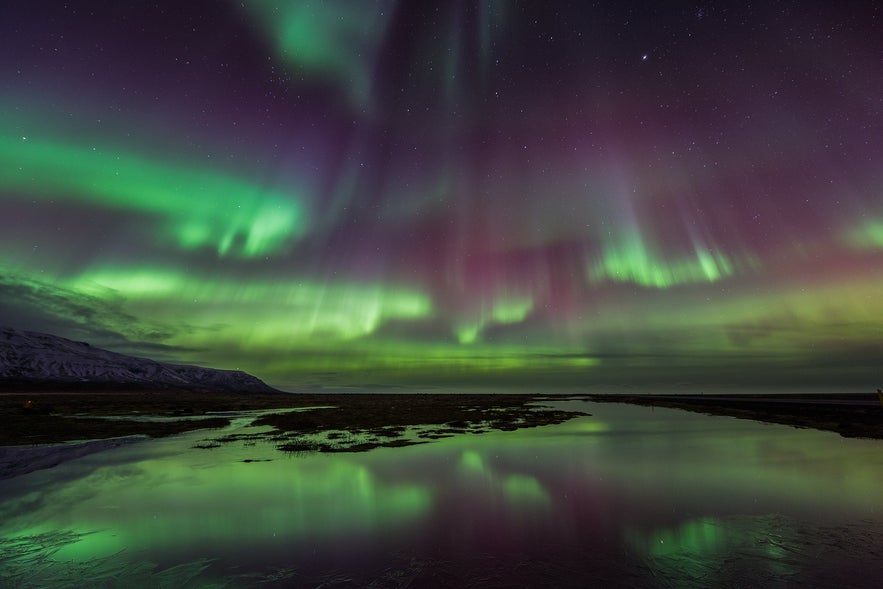 In Iceland, the northern lights are typically visible from late September to April on dark, clear nights, and you may also see them in early spring. The peak viewing season is from November to early March, when the nights are longest.
In Iceland, the northern lights are typically visible from late September to April on dark, clear nights, and you may also see them in early spring. The peak viewing season is from November to early March, when the nights are longest.
Best Months to See the Northern Lights in Reykjavik
If seeing the aurora borealis in all its glory is your priority, consider booking your Iceland vacation for late fall, around late October or November. In autumn, the skies are still dark enough for the lights, and the milder conditions create a more comfortable experience.
Some may think winter is the best time to see the northern lights in Iceland, since December through February brings the longest nights and often the strongest displays. However, the harsh weather during these months can make travel difficult.
Best Time of Night to See the Northern Lights
The best time of night to look for the lights is usually around midnight, although they can appear anytime between sunset and sunrise. Clear skies are essential, as cloud cover will block the view.
2025 and 2026 Northern Lights in Reykjavik
What makes 2025 and 2026 special is that they fall during the solar maximum, the peak of the sun’s activity cycle. This means brighter, stronger, and more frequent northern lights are expected over Iceland, giving you some of the best chances in years to see the aurora in Reykjavik.
It's important to remember that the northern lights are a natural phenomenon, and sightings can never be guaranteed. With patience, a little luck, and perhaps a warm drink in hand, watching them move across the night sky becomes an unforgettable experience.
The Best Places to See the Northern Lights in Reykjavik
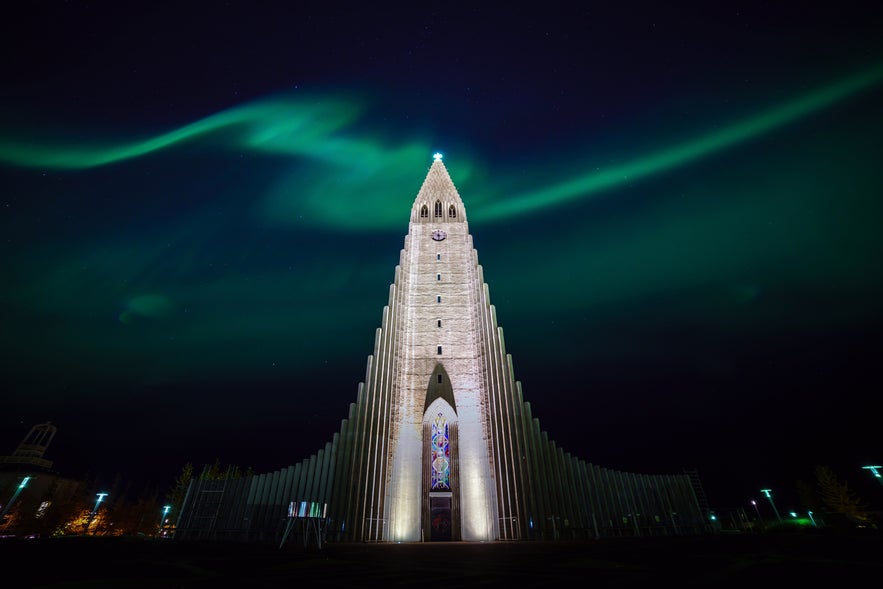 The best places to see the northern lights in Iceland can be almost anywhere with clear, dark skies. Sometimes the most breathtaking display might appear just around the corner from your hotel, even in the heart of Reykjavik.
The best places to see the northern lights in Iceland can be almost anywhere with clear, dark skies. Sometimes the most breathtaking display might appear just around the corner from your hotel, even in the heart of Reykjavik.
To make it easier, this section highlights where to see the northern lights in Reykjavik, with many spots located within walking distance or a short bus ride from the city center.
5. Grandi District
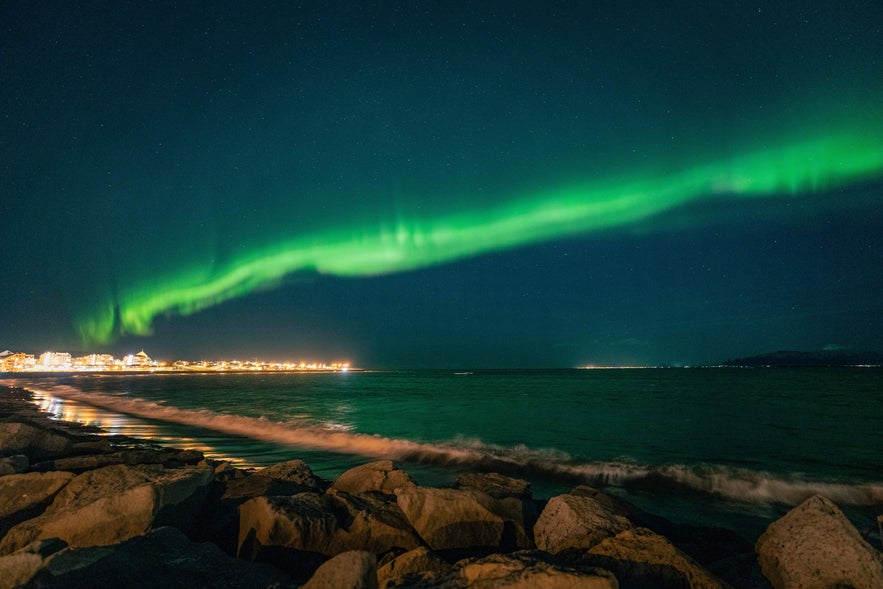
The Grandi District, next to the old harbor in Reykjavik, is a popular place to look for the northern lights while enjoying the city’s cultural scene. Once an industrial fishing area, it has transformed into a lively neighborhood filled with restaurants, shops, and galleries.
Despite being in the city, parts of Grandi are less affected by light pollution. Its open harbor views give you a vast stretch of sky to watch for the aurora.
The district is also home to Aurora Reykjavik, the Northern Lights Center, where you can learn about the science and stories behind the aurora through interactive exhibits and immersive displays. From the waterfront, you’ll also see striking views of Harpa Concert Hall lit up against the night sky, and on clear nights, Mt. Esja in the distance.
4. Klambratun Park
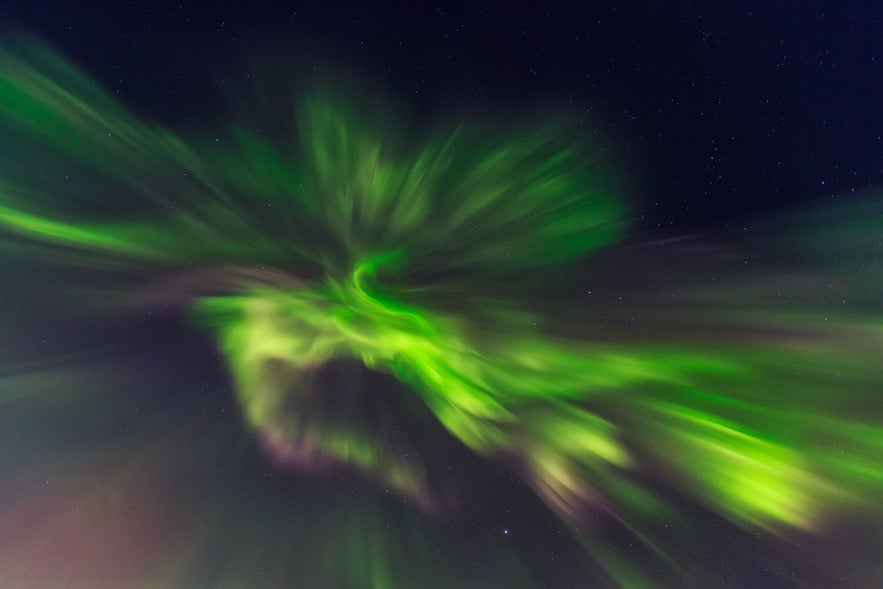
Klambratun Park in central Reykjavik is a green space with open fields and tree-lined paths that offer clear views of the night sky. Although it’s in the city, the park is darker than nearby streets, making it one of the few central places to see the northern lights. Its location near Hlemmur Square makes it a convenient choice for those who want to spot the aurora without leaving the city center.
3. Sun Voyager Sculpture
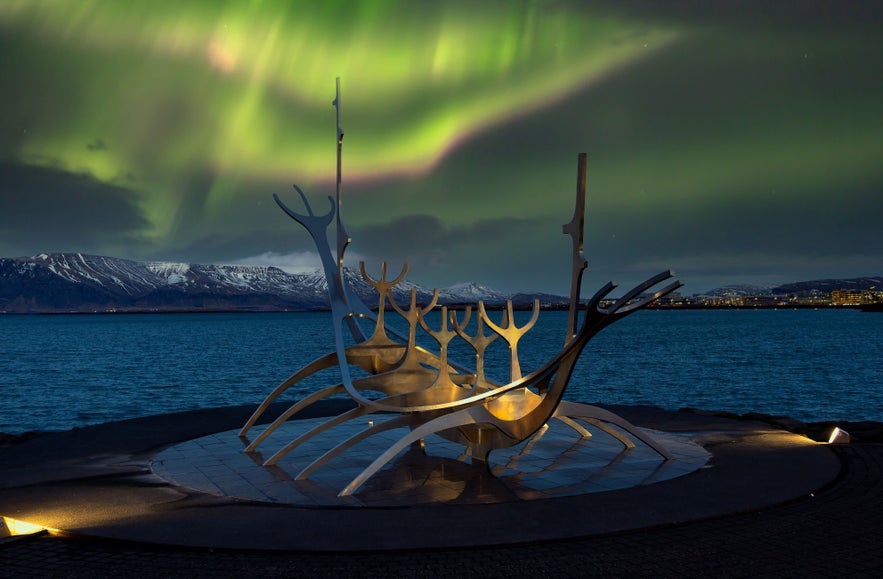 The Sun Voyager Sculpture, or Solfarid, is an iconic landmark and one of the most unique northern lights spots in Reykjavik. This steel sculpture represents a “vessel of dreams” and sits on the city's waterfront, providing an almost unobstructed view of the sky.
The Sun Voyager Sculpture, or Solfarid, is an iconic landmark and one of the most unique northern lights spots in Reykjavik. This steel sculpture represents a “vessel of dreams” and sits on the city's waterfront, providing an almost unobstructed view of the sky.
When the aurora appears, the lights often reflect on the sea with Mt. Esja in the background, creating one of the most photogenic settings in the city. Its artistic design adds a symbolic touch to the experience, while its location makes it an easy and free stop on an evening walk from downtown.
2. Oskjuhlid Hill
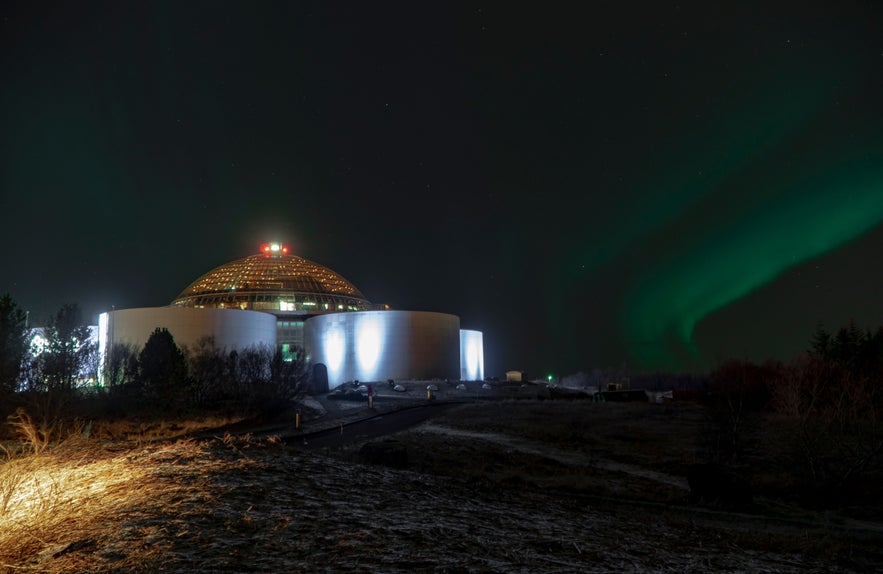 Oskjuhlid Hill is one of the best elevated spots in Reykjavik for viewing the northern lights. Surrounded by woodland trails and sitting above the city, it offers a clear vantage point of the night sky with reduced light pollution compared to downtown. From here, you can enjoy sweeping views over Reykjavik, the coastline, and the surrounding mountains.
Oskjuhlid Hill is one of the best elevated spots in Reykjavik for viewing the northern lights. Surrounded by woodland trails and sitting above the city, it offers a clear vantage point of the night sky with reduced light pollution compared to downtown. From here, you can enjoy sweeping views over Reykjavik, the coastline, and the surrounding mountains.
At the top of the hill stands the glass-domed Perlan, an iconic landmark visible across the city. While it houses exhibitions and a planetarium show during the day, the real highlight at night is stepping outside to the observation deck or nearby paths, where you can wait for the aurora to light up the sky.
1. Grotta Nature Reserve
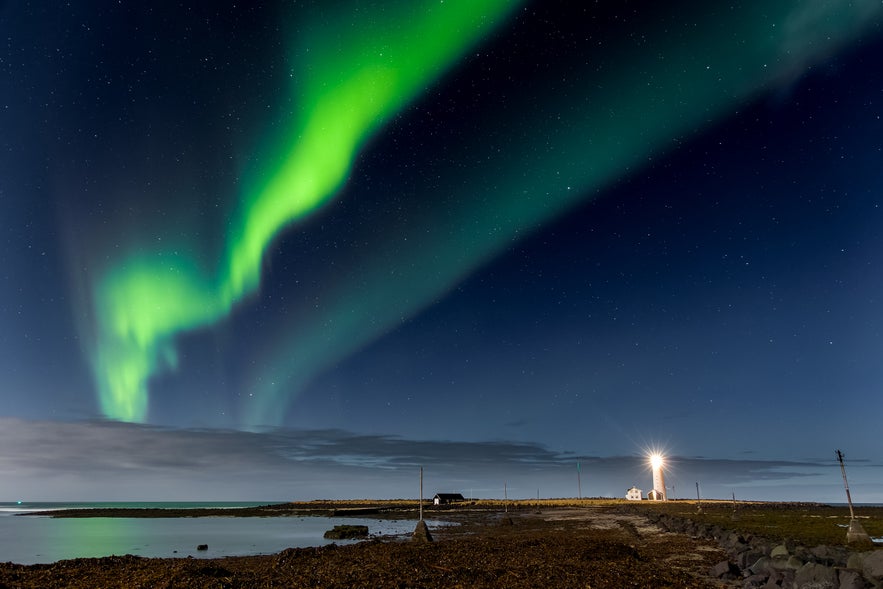 On the edge of the Seltjarnarnes Peninsula, you'll find Grotta, a nature reserve along the coast with an iconic lighthouse. Despite being close to the city center, the area is mostly free of light pollution, which makes it an ideal spot for witnessing the northern lights.
On the edge of the Seltjarnarnes Peninsula, you'll find Grotta, a nature reserve along the coast with an iconic lighthouse. Despite being close to the city center, the area is mostly free of light pollution, which makes it an ideal spot for witnessing the northern lights.
The open view over the ocean gives you a wide horizon, so it is easier to catch the aurora as it moves across the sky. Grotta is only about 3 miles (5 kilometers) from downtown and easy to reach by car, bus, or even on foot along the scenic coastline.
The Best Places to See the Northern Lights Near Reykjavik
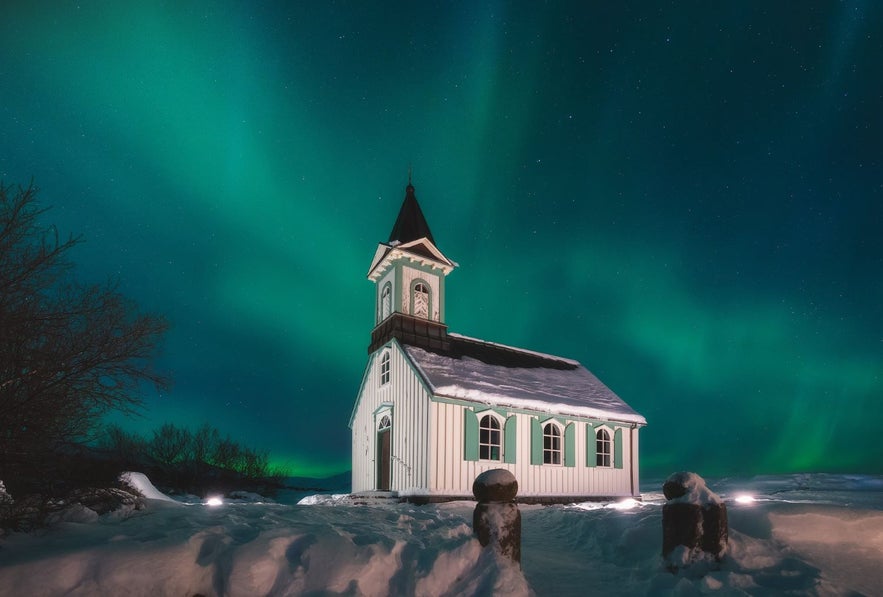 If you're planning on hunting for the northern lights somewhere near Reykjavik, it’s easiest to travel by rental car. In the fall, renting a small car is usually enough. However, in the height of winter, a 4x4 vehicle provides more stability and safety. Driving also gives you access to less crowded spots outside the city.
If you're planning on hunting for the northern lights somewhere near Reykjavik, it’s easiest to travel by rental car. In the fall, renting a small car is usually enough. However, in the height of winter, a 4x4 vehicle provides more stability and safety. Driving also gives you access to less crowded spots outside the city.
With that in mind, this section highlights where to see the northern lights near Reykjavik within an hour’s drive of the center, offering darker skies and quieter surroundings for a better view.
10. Thingvellir National Park
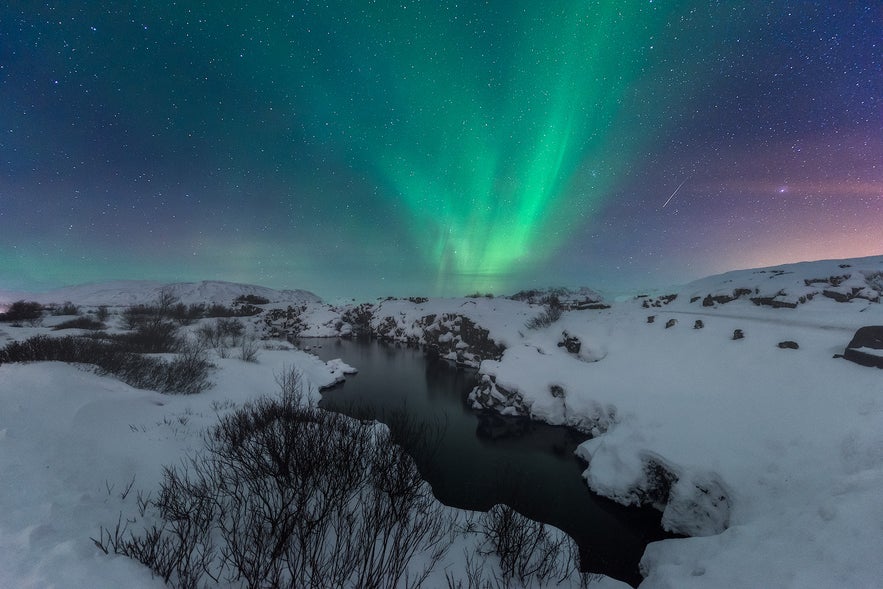 A UNESCO World Heritage site, Thingvellir National Park is approximately 27 miles (44 kilometers) from Reykjavik and a popular destination for guided Iceland northern lights tours. Its distance from the city and expansive open spaces provide excellent conditions for aurora viewing.
A UNESCO World Heritage site, Thingvellir National Park is approximately 27 miles (44 kilometers) from Reykjavik and a popular destination for guided Iceland northern lights tours. Its distance from the city and expansive open spaces provide excellent conditions for aurora viewing.
The park also boasts incredible natural landscapes, with unique geological features such as exposed North American and Eurasian tectonic plates. It's one of the three main stops of the popular Golden Circle route and a must-see for any trip to Iceland.
9. Kleifarvatn Lake
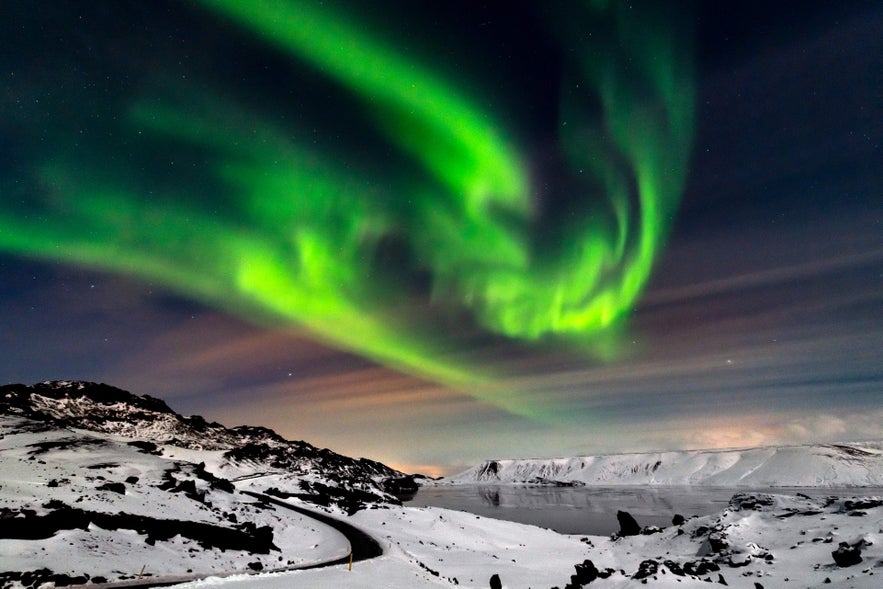 Only 22 miles (32 kilometers) from central Reykjavik, you'll find Kleifarvatn, the largest lake on the Reykjanes Peninsula. The lake is surrounded by dramatic cliffs steeped in Icelandic folklore. It’s said to be inhabited by a mythical water creature.
Only 22 miles (32 kilometers) from central Reykjavik, you'll find Kleifarvatn, the largest lake on the Reykjanes Peninsula. The lake is surrounded by dramatic cliffs steeped in Icelandic folklore. It’s said to be inhabited by a mythical water creature.
Be careful when driving along the lake, as the road can be tricky to maneuver in the dark. You can, however, find many northern lights viewpoints where it is safe to stop.
8. Esja Mountain
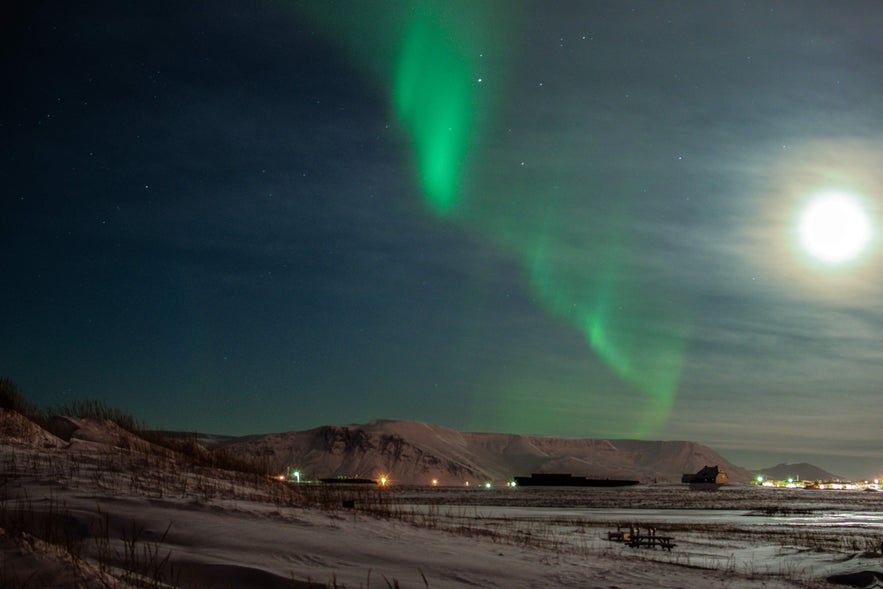 Across the bay from Reykjavik, you will see the beautiful Mt. Esja, also known as Esjan. While we don't recommend hiking in the dark of winter, the base of Esjan is far enough from the city lights to increase your chances of seeing the aurora.
Across the bay from Reykjavik, you will see the beautiful Mt. Esja, also known as Esjan. While we don't recommend hiking in the dark of winter, the base of Esjan is far enough from the city lights to increase your chances of seeing the aurora.
7. Hvaleyravatn Lake
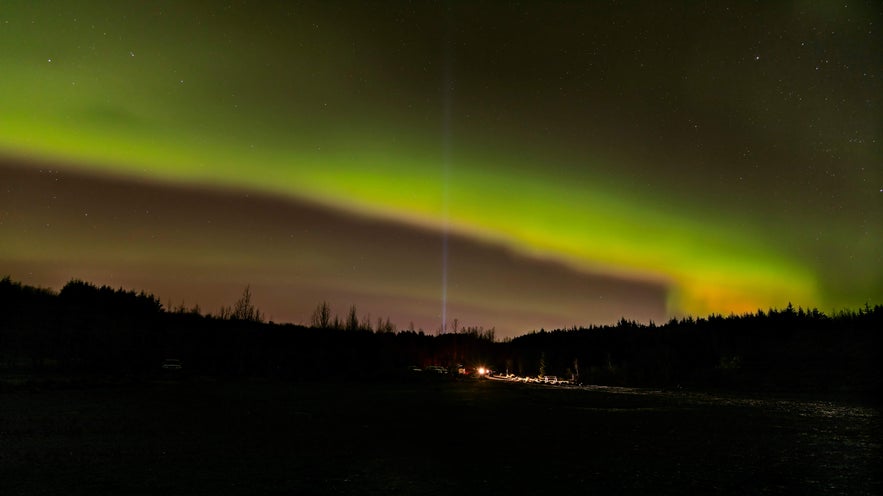 Hvaleyravatn is a serene lake near the charming town of Hafnarfjordur, 10.5 miles (17 kilometers) from Reykjavik. Its peaceful surroundings make it a perfect spot for stargazing.
Hvaleyravatn is a serene lake near the charming town of Hafnarfjordur, 10.5 miles (17 kilometers) from Reykjavik. Its peaceful surroundings make it a perfect spot for stargazing.
6. Hafravatn Lake
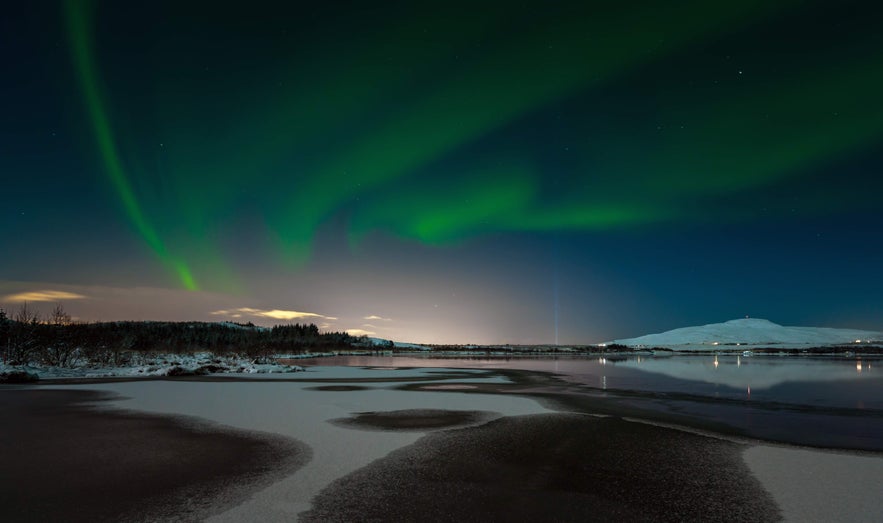
The serene Lake Hafravatn is 11 miles (8 kilometers) from the city center. Its tranquil, dark surroundings make it a great place to see the auroras. In the vicinity, the smaller lake of Reynisvatn offers a similarly peaceful, rural setting for a striking light show.
5. Straumur Bay
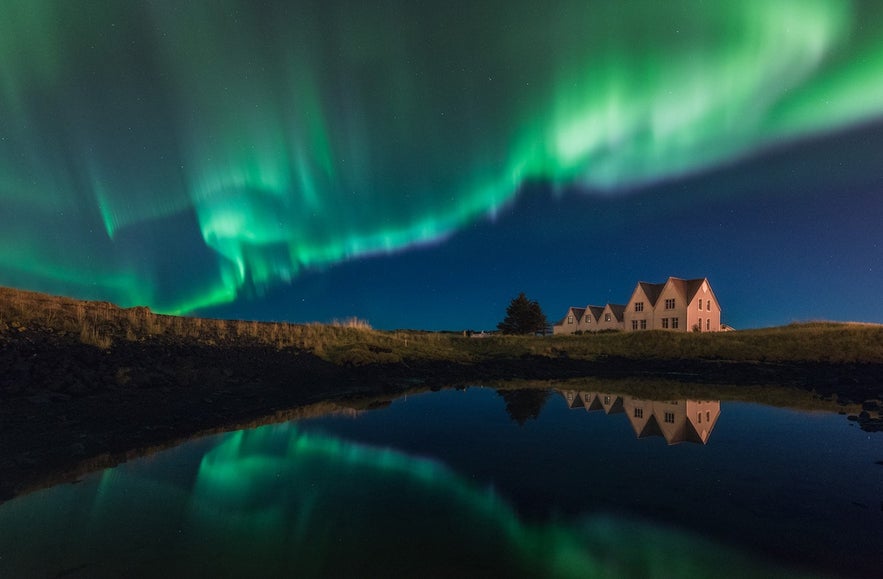
Straumsvik Bay in the town of Hafnarfjordur, also known as Straumur, is 5 miles (8 kilometers) from the center of Reykjavik. This site offers a spectacular view of the ocean from the edge of a lava field, and you'll also find some picturesque old houses in the area that make for interesting photo opportunities.
4. Ulfarsfell Mountain
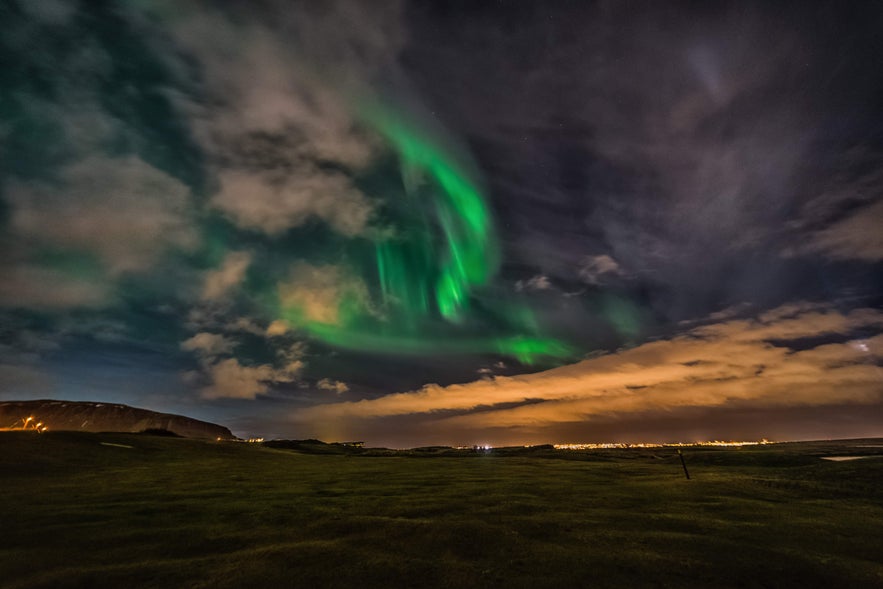 An adventurous spot for northern lights hunting is Ulfarsfell, a small mountain located in the town of Mosfellsbaer, 10.5 miles (17 kilometers) from downtown Reykjavik. With a higher vantage point and dark skies, you have a good chance of seeing the aurora.
An adventurous spot for northern lights hunting is Ulfarsfell, a small mountain located in the town of Mosfellsbaer, 10.5 miles (17 kilometers) from downtown Reykjavik. With a higher vantage point and dark skies, you have a good chance of seeing the aurora.
There are marked hiking paths to the top of the mountain. Just make sure to bring a good flashlight or headlight and walk carefully.
3. Heidmork Nature Reserve
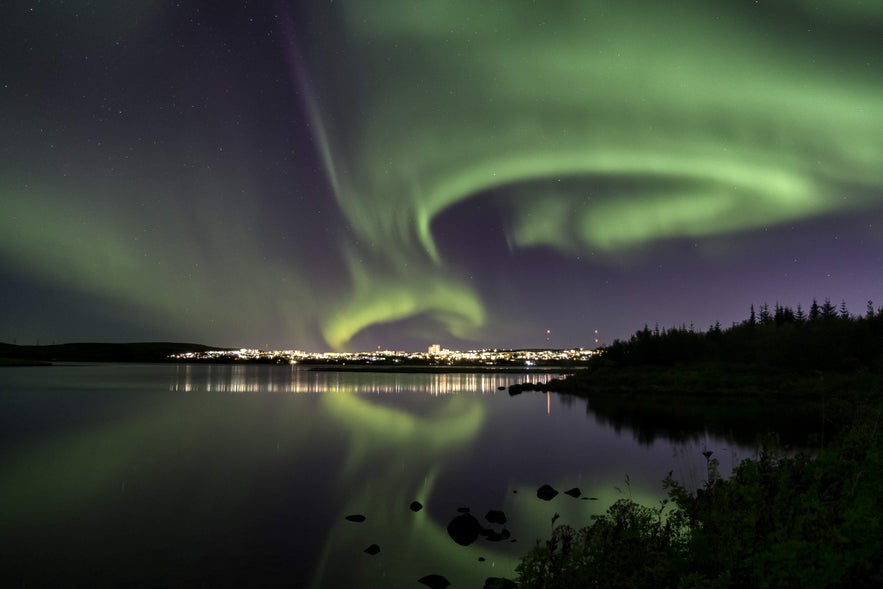 Located on the outskirts of Reykjavik, Heidmork is a large nature reserve that offers wide-open spaces and minimal light pollution for optimal aurora conditions. It also boasts natural backdrops like Ellidavatn Lake and the Raudholar Pseudocraters, making for great northern lights photographs.
Located on the outskirts of Reykjavik, Heidmork is a large nature reserve that offers wide-open spaces and minimal light pollution for optimal aurora conditions. It also boasts natural backdrops like Ellidavatn Lake and the Raudholar Pseudocraters, making for great northern lights photographs.
2. Vifilsstadavatn Lake
 In the town of Gardabaer, also around 6 miles (10 kilometers) from the city center, you'll find Vifilstadavatn, a serene lake and nature area. Its idyllic setting, proximity to the city, and absence of light pollution make it particularly appealing among Reykjavik aurora spots.
In the town of Gardabaer, also around 6 miles (10 kilometers) from the city center, you'll find Vifilstadavatn, a serene lake and nature area. Its idyllic setting, proximity to the city, and absence of light pollution make it particularly appealing among Reykjavik aurora spots.
1. Ellidaardalur Valley
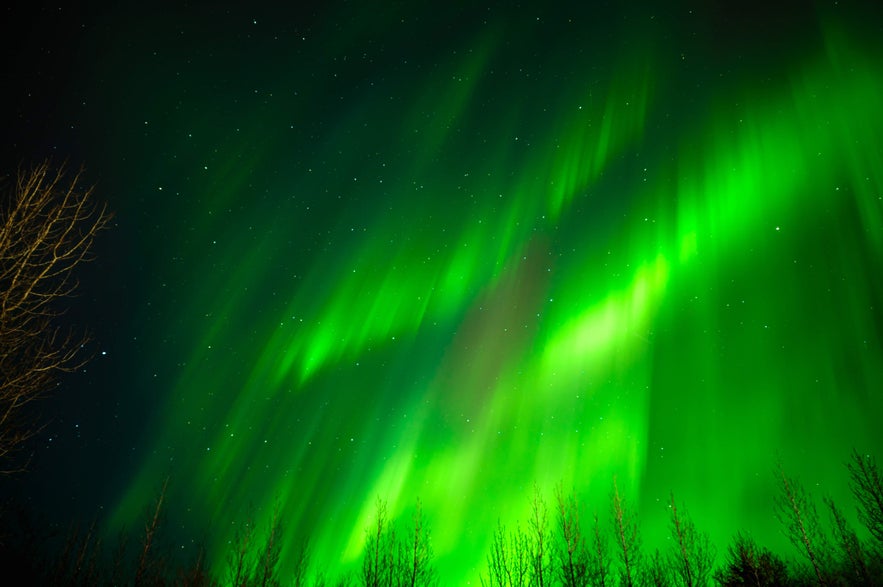 Ellidaardalur is a popular valley and nature area near the Ellidaa River. Its open spaces and distance from city lights make it a clear and dark environment for aurora-watching. It’s about 6 miles (10 kilometers) from the city center.
Ellidaardalur is a popular valley and nature area near the Ellidaa River. Its open spaces and distance from city lights make it a clear and dark environment for aurora-watching. It’s about 6 miles (10 kilometers) from the city center.
The Top 6 Best Places to See the Northern Lights Outside Reykjavik
The northern lights can be seen from most places in Iceland. You can easily combine northern light hunting with a tour of the Icelandic countryside. Traveling further from Reykjavik can lead to many spectacular photo opportunities at some of the country's most majestic natural attractions.
A self-drive tour is a suitable option in the fall when the weather is still relatively mild. However, if you're visiting Iceland in winter, we recommend opting for guided tours instead, as driving conditions can be difficult and road closures are common. This advice especially applies to those who are not comfortable driving in heavy snow, ice, and strong winds.
6. Borgarfjordur Fjord
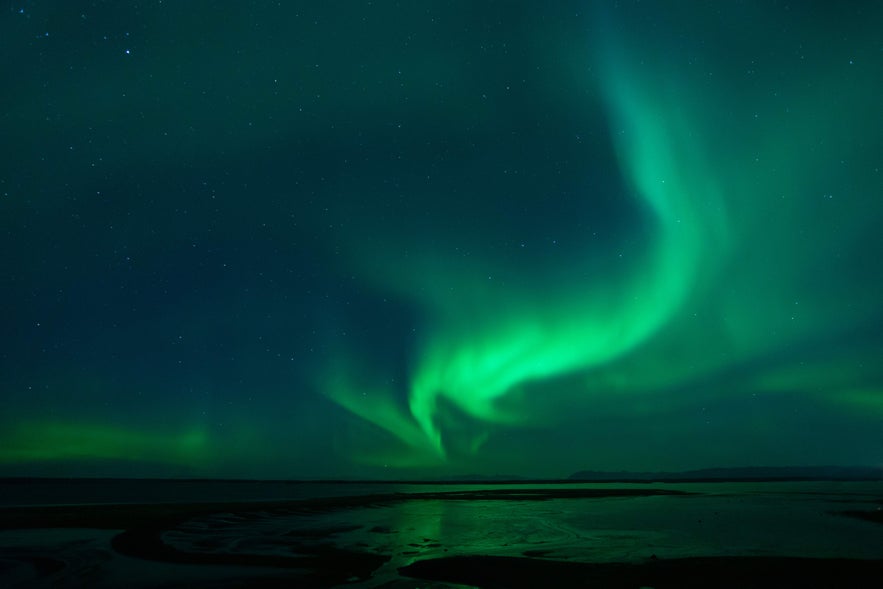 Borgarfjordur is a wide fjord in West Iceland, about 42 miles (68 kilometers) from Reykjavik. Its dark skies make it a great spot for northern lights viewing.
Borgarfjordur is a wide fjord in West Iceland, about 42 miles (68 kilometers) from Reykjavik. Its dark skies make it a great spot for northern lights viewing.
The town of Borgarnes is a good base, and nearby sights like the Hraunfossar Waterfalls look even more magical under the aurora. On the way, you can stop at Krauma Spa, which uses water from Deildartunguhver, Europe’s most powerful hot spring. Here you can relax in the warm pools and, with clear skies, enjoy the northern lights at the same time.
5. Snaefellsnes Peninsula
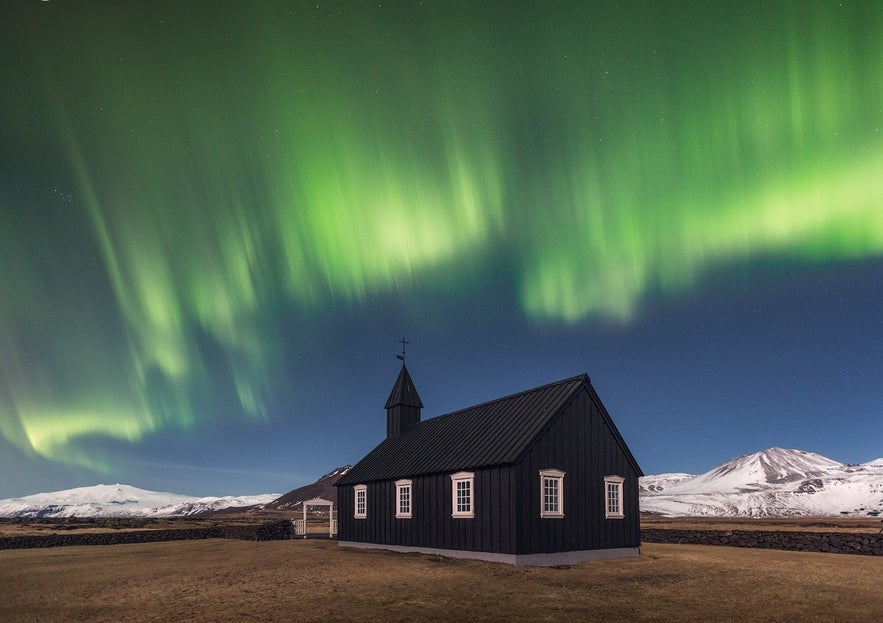 Searching for the northern lights along the Snaefellsnes Peninsula can be magical. The area features striking landscapes, such as the iconic Kirkjufell Mountain and the Arnarstapi Cliffs. Charming towns, including Stykkisholmur and Olafsvik, have low light pollution, allowing for clear viewing. It’s highly recommended to take more than a day to explore Snaefellsnes since it has so much to offer.
Searching for the northern lights along the Snaefellsnes Peninsula can be magical. The area features striking landscapes, such as the iconic Kirkjufell Mountain and the Arnarstapi Cliffs. Charming towns, including Stykkisholmur and Olafsvik, have low light pollution, allowing for clear viewing. It’s highly recommended to take more than a day to explore Snaefellsnes since it has so much to offer.
4. South Coast
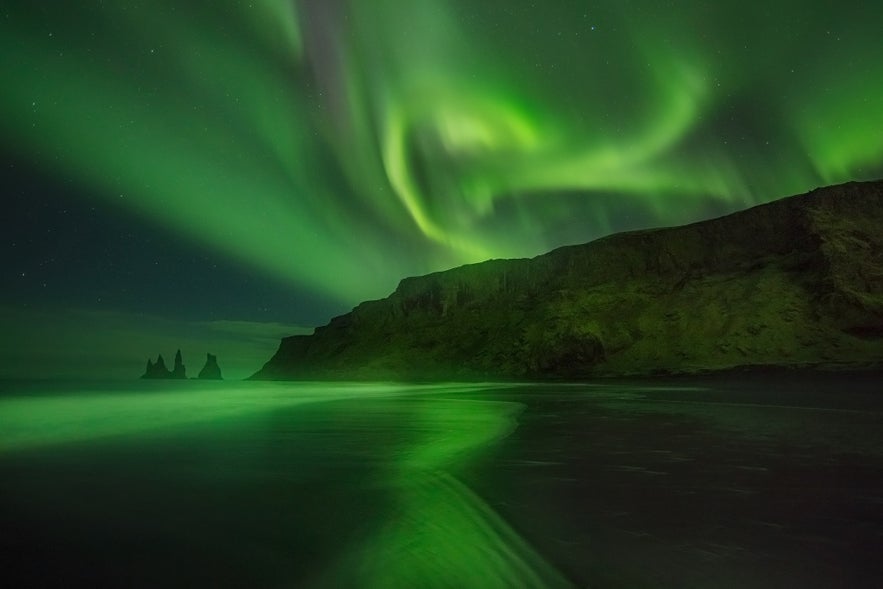 A self-drive tour along Iceland's South Coast lets you combine aurora hunting with some of the country’s most visited southern sights. You’ll find quiet spots near Threngslin, like the Raufarholshellir Lava Cave, that offer darker skies away from the crowds.
A self-drive tour along Iceland's South Coast lets you combine aurora hunting with some of the country’s most visited southern sights. You’ll find quiet spots near Threngslin, like the Raufarholshellir Lava Cave, that offer darker skies away from the crowds.
The Seljalandsfoss and Skogafoss Waterfalls, the famous black sand beaches of Reynisfjara, the Jokulsarlon Glacier Lagoon, and Diamond Beach create breathtaking backdrops if the northern lights appear. Stops in the towns of Hveragerdi, Hella, and Vik make the journey even more rewarding while you wait for the aurora.
3. Hvalfjordur Fjord
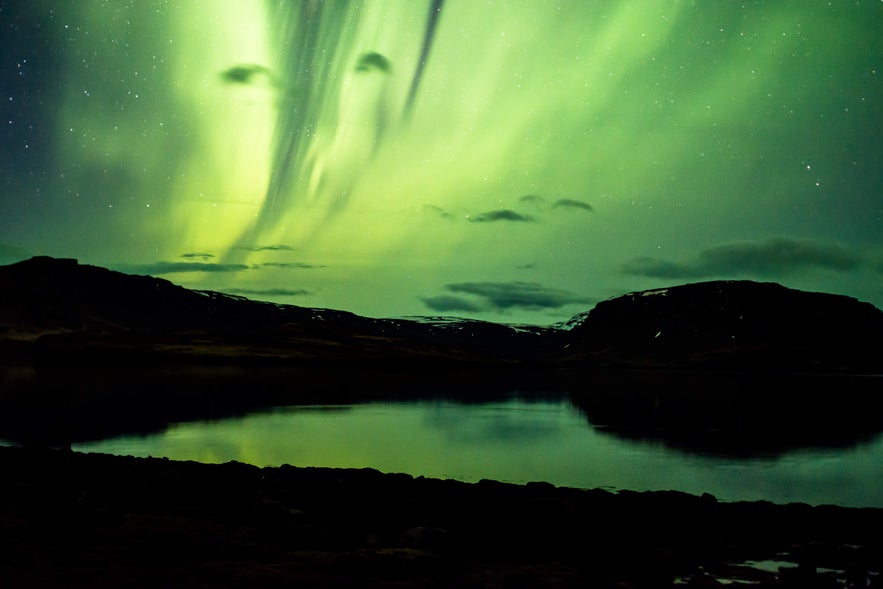 Hvalfjordur is a serene fjord located 33 miles (53 kilometers) north of Reykjavik. Its remote location provides dark skies, making it an excellent place to watch the northern lights dance and reflect on the still waters.
Hvalfjordur is a serene fjord located 33 miles (53 kilometers) north of Reykjavik. Its remote location provides dark skies, making it an excellent place to watch the northern lights dance and reflect on the still waters.
You can also enhance the experience with a visit to the nearby Hvammsvik Hot Springs, where you can relax in warm geothermal pools while waiting for the aurora. On the way, you can do a short detour to the town of Akranes. It has a scenic lighthouse that adds a beautiful stop to your journey.
2. The Golden Circle
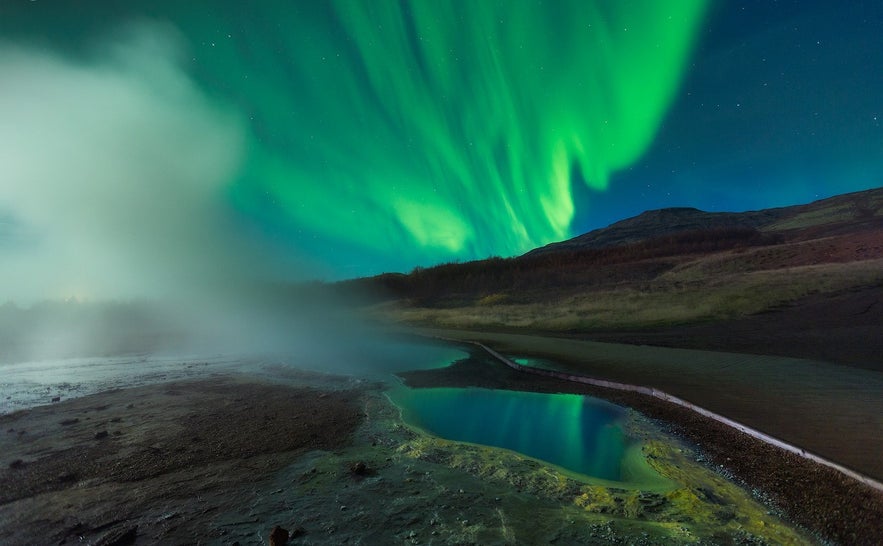 Searching for the northern lights while exploring the Golden Circle gives you the chance to see the aurora over some of Iceland’s most iconic landmarks. It's the most popular tourist route in Iceland for a reason, as it includes the historic Thingvellir National Park, Geysir Geothermal Area, and Gullfoss Waterfall. Being outside Reykjavik also means darker skies, which makes it easier to spot the magnificent natural light show.
Searching for the northern lights while exploring the Golden Circle gives you the chance to see the aurora over some of Iceland’s most iconic landmarks. It's the most popular tourist route in Iceland for a reason, as it includes the historic Thingvellir National Park, Geysir Geothermal Area, and Gullfoss Waterfall. Being outside Reykjavik also means darker skies, which makes it easier to spot the magnificent natural light show.
1. Reykjanes Peninsula
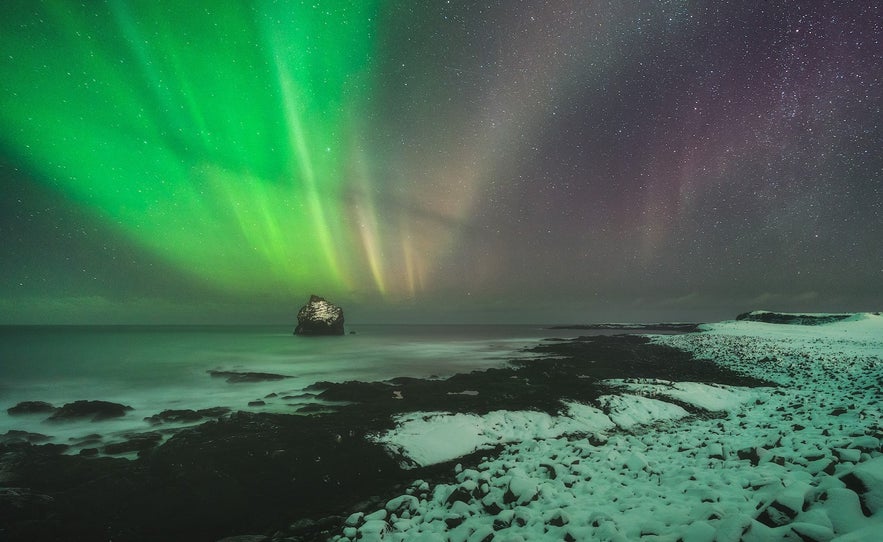 Along the coastline, the dark, open skies provide an ideal canvas for the aurora borealis. You can stop in the towns of Keflavik and Gardur, where you can find the lovely Gardskagaviti lighthouses.
Along the coastline, the dark, open skies provide an ideal canvas for the aurora borealis. You can stop in the towns of Keflavik and Gardur, where you can find the lovely Gardskagaviti lighthouses.
We recommend pairing your aurora hunt in Reykjanes with a visit to the nearby Blue Lagoon geothermal spa. Just make sure to book your Blue Lagoon tickets well ahead of time to guarantee your spot.
There are many locations to choose from when hunting for the northern lights from Reykjavik. For a better chance of success, consider planning a multi-day trip so you can cover more ground and spend longer under dark skies.
You’ll also find plenty of great accommodations in Iceland, making it easy to base yourself near top viewing spots. If you’re only planning a day trip from Reykjavik, remember that daylight is limited in fall and winter, so plan your time carefully.
How to Get to the Best Aurora Spots Near Reykjavik
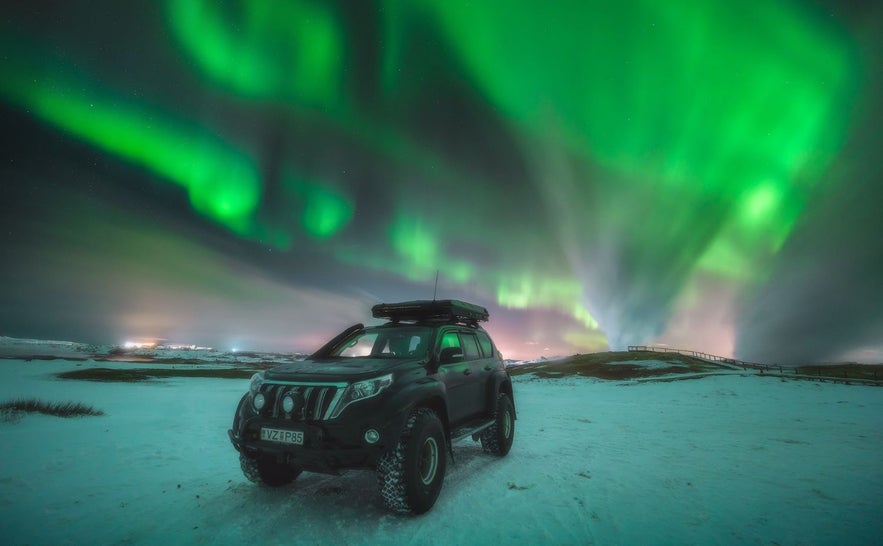 There are many locations to choose from when hunting for the northern lights from Reykjavik. Seeking the aurora borealis is an adventure, and both self-drive and guided tours offer their own unique advantages. You should also consider how much time you have, as tour options range from two-hour cruises to two-week packages and beyond.
There are many locations to choose from when hunting for the northern lights from Reykjavik. Seeking the aurora borealis is an adventure, and both self-drive and guided tours offer their own unique advantages. You should also consider how much time you have, as tour options range from two-hour cruises to two-week packages and beyond.
Guided Northern Lights Day Tours
Guided day tours in Iceland offer a well-structured experience led by experienced guides adept at predicting sightings.
-
Northern Lights Bus Tour: Take advantage of your guide’s expertise with this bus tour, which will whisk you to whatever locale near Reykjavik you’re most likely to spot the light show.
-
Northern Lights Boat Cruise: Set sail from Reykjavik’s Old Harbour and away from the city lights to catch the aurora borealis over the water.
-
Northern Lights Jeep Tour: Take on the Icelandic terrain in a customized 4x4 for this adventurous tour, which includes free photos.
Note: While sightings aren’t guaranteed, many tours offer another attempt free of charge should you miss out on the northern lights the first time.
Northern Lights Self-Drive Tours
If you're comfortable navigating Iceland's roads in the dark and adapting to weather conditions, you can strike out on your own to explore viewing locations beyond Reykjavik on winter self-drive tours.
-
3-Day South Iceland Winter Self-Drive: Visit the most essential spots for aurora-spotting on the South Coast and go ice caving in Vatnajokull National Park.
-
6-Day Self-Drive on the South Coast: An efficient winter journey to the Golden Circle, South Coast, and Southeast Iceland, with an optional, once-in-a-lifetime ice caving tour.
-
7-Day Self-Drive with Golden Circle and South Iceland: A comprehensive, customizable tour of the Snaefellsnes Peninsula, the Golden Circle, and the South Coast, hitting several northern lights viewing points.
-
10-Day Ring Road Self-Drive Tour: A sweeping journey hitting all the highlights of the Ring Road, perfect for thrill-seeking travelers who prefer to choose their own destiny.
-
2-Week Epic Circle of Iceland Self-Drive: Spend more time exploring each landmark and natural wonders on the Ring Road with this leisurely 15-day tour.
Northern Lights Vacation Packages
 If you want to explore larger areas, pack in more activities, and have all your accommodations and travel taken care of, consider booking winter vacation packages in Iceland.
If you want to explore larger areas, pack in more activities, and have all your accommodations and travel taken care of, consider booking winter vacation packages in Iceland.
-
5-Day Northern Lights Winter Vacation: Spot the northern lights from hot spots, including the Blue Lagoon, Reykjavik, the Golden Circle, the South Coast, and the Jokulsarlon Glacier Lagoon.
-
6-Day Winter Adventure Package: Take in even more Golden Circle sights with this slightly longer tour.
-
7-Day Winter Package with Ice Caving: This week-long, stress-free expedition includes stops at all three of Iceland’s national parks.
-
8-Day Winter Vacation with National Parks: Traverse the stunning landscapes of Iceland with this package, which hits Reykjavik, the South Coast, West Iceland, and more.
-
10-Day Circle of Iceland Winter Package: Search for the aurora borealis from ideal vantage points across Jokulsarlon Glacier Lagoon, the Lake Myvatn area, the Snaefellsnes Peninsula, and the Golden Circle.
Guided Northern Lights Multi-Day Tours
Guided multi-day tours offer distinct advantages for first-time visitors and those less confident handling Iceland's variable weather. All of your travel will be arranged for you, as well as your itinerary and accommodations, and you’ll have a dedicated guide for the entire trip.
-
2-Day Snaefellsnes Peninsula Tour: Travel from Reykjavik to the Snaefellsnes Peninsula with a knowledgeable guide for your best chance to spot the northern lights.
-
3-Day Golden Circle and South Coast Winter Tour: Take in all the must-see sights across the Golden Circle and the South Coast with this tour, perfect for travelers on a tight schedule.
-
4-Day Northern Lights Tour with Ice Caving: Spend three days being expertly guided around the South Coast exploring the Snaefellsnes Peninsula on this northern lights tour.
-
6-Day Ring Road Winter Tour: Journey around the Ring Road with this guided minibus tour, which includes hidden gems as well as major attractions.
-
8-Day Ring Road Minibus Winter Tour: This small group guided tour with cozy accommodations includes visits to Thingvellir National Park, Diamond Beach, and the Eastfjords.
What Are the Northern Lights?
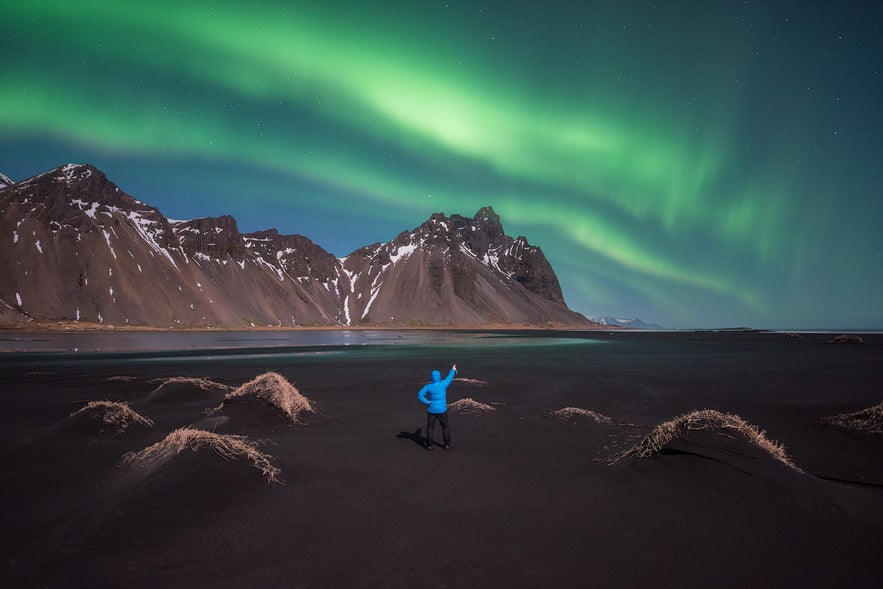 The northern lights, also known as the aurora borealis, are a natural light display that appears in the night sky as moving waves or curtains of color. They are most often seen in places close to the Arctic, like Iceland, where the skies can glow in shades of green, pink, red, and violet.
The northern lights, also known as the aurora borealis, are a natural light display that appears in the night sky as moving waves or curtains of color. They are most often seen in places close to the Arctic, like Iceland, where the skies can glow in shades of green, pink, red, and violet.
These lights happen when charged particles from the sun are carried toward Earth by solar wind. As they reach our planet, they are pulled toward the polar regions by Earth’s magnetic field. When the particles collide with gases in the atmosphere, they release energy as light, creating the colors of the aurora.
Even though science explains how they form, the northern lights still feel magical. For centuries, they have inspired myths and legends, sometimes seen as spirits or omens. Today, they continue to draw people from around the world to Iceland in hopes of witnessing one of nature’s most beautiful shows.
Optimal Conditions for Seeing the Northern Lights in Iceland
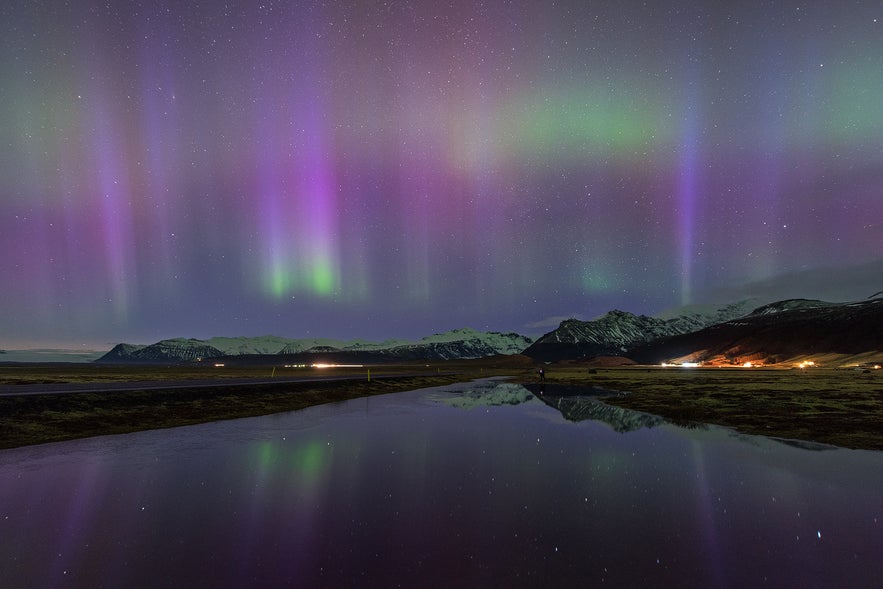 Catching the northern lights in Iceland depends on more than luck. A few natural factors need to align, and knowing how to read forecasts can make a big difference in your chances.
Catching the northern lights in Iceland depends on more than luck. A few natural factors need to align, and knowing how to read forecasts can make a big difference in your chances.
Basic Conditions Needed for Seeing the Northern Lights
-
Darkness: The skies need to be dark to spot the northern lights. The best times are during fall and winter, when daylight hours are minimal.
-
Clear Skies: Cloud cover will obstruct your view. The weather can be unpredictable in Iceland, so check the forecast before embarking on your hunt.
-
Low light pollution: If the aurora is strong, you can see the northern lights in central Reykjavik. However, going to darker locations will increase your chances.
-
Solar activity: The northern lights are the result of particles from the sun interacting with the Earth's magnetic field. Therefore, the stronger the solar activity, the more vibrant the lights.
Advanced Aurora Forecast Tools for Seeing the Northern Lights
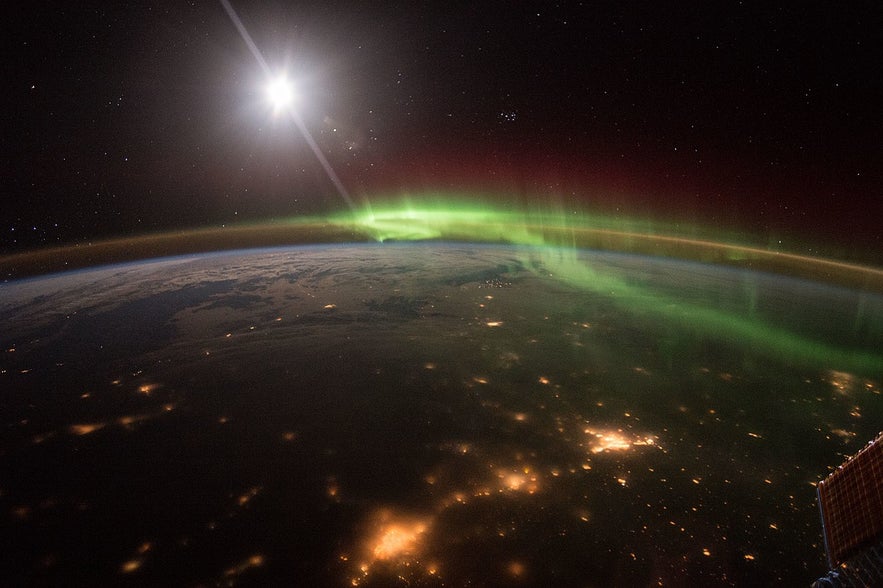 Aurora forecasts are valuable tools for planning your night. They combine solar activity with cloud cover to give you an idea of when and where the lights may appear.
Aurora forecasts are valuable tools for planning your night. They combine solar activity with cloud cover to give you an idea of when and where the lights may appear.
-
Icelandic Meteorological Office (IMO): The Icelandic Meteorological Office offers an invaluable aurora forecast on its website. Provides a map showing expected cloud cover and aurora strength on a scale from 0 to 9. A score of 0 means little chance, while 9 means very strong activity. Most good displays happen at 3 or higher, as long as the skies are clear.
-
National Oceanic and Atmospheric Administration (NOAA) and the Space Weather Prediction Center (SWPC): NOAA runs the SWPC, which publishes northern lights forecasts based on solar activity. On their website, you can quickly see the expected level of aurora activity at a glance.
-
Bz value of the solar wind: Some forecasts show a number called “Bz.” If it points south, your chances of seeing the northern lights go up. In short, check if Bz is negative; it means conditions are more favorable.
-
OVATION model: This is a global map that highlights where auroras are most likely at any given moment. It’s a quick way to see if Iceland is in the “active zone” before heading out.
-
Mobile apps: Apps like Aurora Forecast or My Aurora Forecast take this data and make it simple. They send you alerts when the odds improve in your area, so you don’t have to keep checking charts.
Places to Stay to See the Northern Lights in Reykjavik
 Whether you’re planning to stay close to the city center or use it as a home base for broader Iceland travels, there are many excellent northern lights hotels in Reykjavik and across Iceland for every type of traveler.
Whether you’re planning to stay close to the city center or use it as a home base for broader Iceland travels, there are many excellent northern lights hotels in Reykjavik and across Iceland for every type of traveler.
-
The Reykjavik EDITION: This five-star hotel offers a high-end Icelandic experience with countless amenities and stylish decor.
-
Hotel Lotus: This small, family-owned hotel provides a family-friendly experience with attractions like the Laugardalslaug Swimming Pool and the Reykjavik Family Park & Zoo nearby. Some rooms feature private balconies for convenient northern lights viewing under the right conditions.
-
Berjaya Reykjavik Marina Hotel: This hotel is located near Reykjavik’s Old Harbour and offers a wide variety of rooms for different needs and budgets.
-
Reykjavik Residence Apartment Hotel: For a homier experience, try these apartment-style accommodations in the heart of the city.
-
Reykjavik Konsulat Hotel, Curio Collection By Hilton: This hotel, housed in a historic site near the harbor, boasts an on-site bathhouse, as well as delicious dining options.
Practical Tips for Spotting the Northern Lights
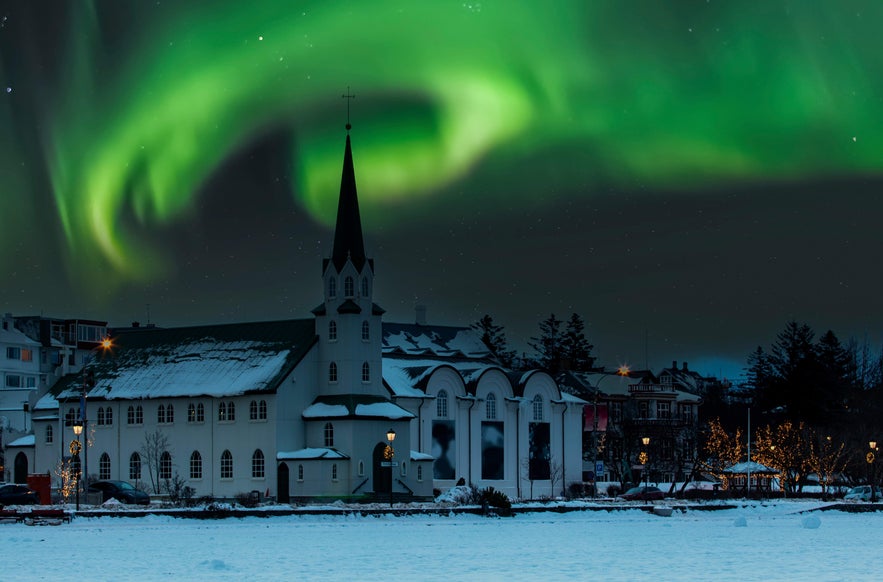 When hunting for the northern lights in Reykjavik, a little preparation goes a long way. Use these tips to stay safe, warm, and comfortable.
When hunting for the northern lights in Reykjavik, a little preparation goes a long way. Use these tips to stay safe, warm, and comfortable.
-
Check the weather and road forecast from the Icelandic Meteorological Office (IMO), especially in winter.
-
If driving, rent a car that can handle icy roads. Avoid remote areas unless you are with a guide, as it’s easy to get lost.
-
Dress in layers and know what to wear in Iceland. Start with thermal underwear to keep warmth close to your body. Add a fleece or wool sweater, then finish with a waterproof and windproof jacket. Layers make it easy to adjust as needed.
-
Keep your hands, feet, and head warm. Wear thick socks, insulated boots, gloves or mittens, and a hat. Touchscreen gloves are useful if you plan to take photos.
-
Bring extra warmth if you’ll be waiting outside. A blanket, a seat pad, or a hot drink in a thermos can make the wait much more comfortable.
-
Respect the land. Never trespass on private property or drive off-road. Always follow local rules for a safe northern lights adventure.
How to Photograph the Northern Lights
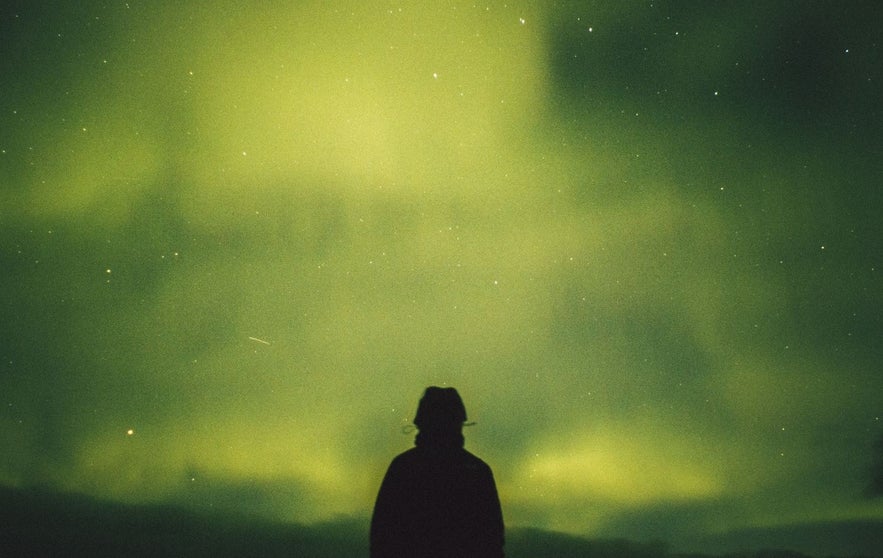 Photographing the northern lights is tricky but can yield stunning results with a bit of planning and creativity. Keep in mind that you'll likely have to use a proper camera, as smartphones are generally not as adept at capturing the aurora. Here are some tips to get you started.
Photographing the northern lights is tricky but can yield stunning results with a bit of planning and creativity. Keep in mind that you'll likely have to use a proper camera, as smartphones are generally not as adept at capturing the aurora. Here are some tips to get you started.
-
Stability is key: Use a tripod to stabilize your camera. Northern lights photography requires longer exposure times, which could lead to blurry images with a handheld camera.
-
Shoot wide and high: Utilize a wide-angle lens to capture more of the sky, and don't forget to include some of the landscape to add a sense of scale and location.
-
Experiment: Try different exposure lengths, but remember that very long exposures may result in capturing star movement, altering the final image.
-
Focus: Ensure your camera is focused to infinity. Autofocus can struggle in low-light conditions, so manual focus is usually your best bet.
-
Bring extra batteries: Cold conditions can drain battery power quickly, so bring extras and keep them warm until you need them.
If you're not a do-it-yourself photographer, consider joining a northern lights tour with free photos.
Generally speaking, the aurora will appear stronger in photographs than they do to the naked eye. When aurora activity appears faint, use your camera to give it a boost.
Visiting Aurora Museums in Reykjavik
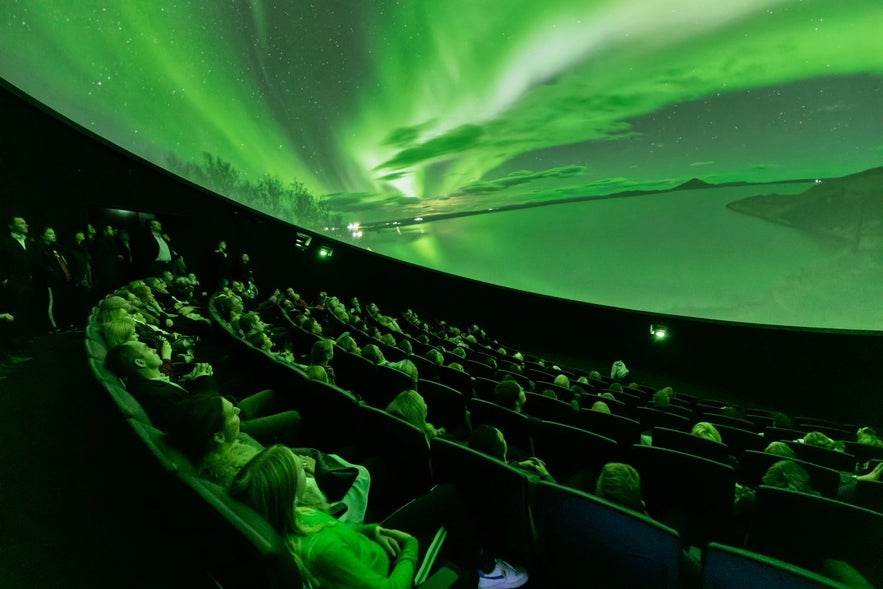 Don't despair if luck isn't on your side during your time in Reykjavik and conditions don't align for seeing the northern lights in person.
Don't despair if luck isn't on your side during your time in Reykjavik and conditions don't align for seeing the northern lights in person.
You can enjoy the northern lights show at the Perlan Planetarium to experience the aurora magic in a comfortable indoor setting. The show is also very informative, explaining the science behind the phenomenon and delving into the folklore it has inspired.
Or you could visit The Aurora Reykjavik Northern Lights Center, which is entirely dedicated to the northern lights. It offers information about contemporary research and takes a deep dive into its cultural history. Interactive exhibits make this an engaging and educational visit for all ages.
FAQs About the Northern Lights in Reykjavik
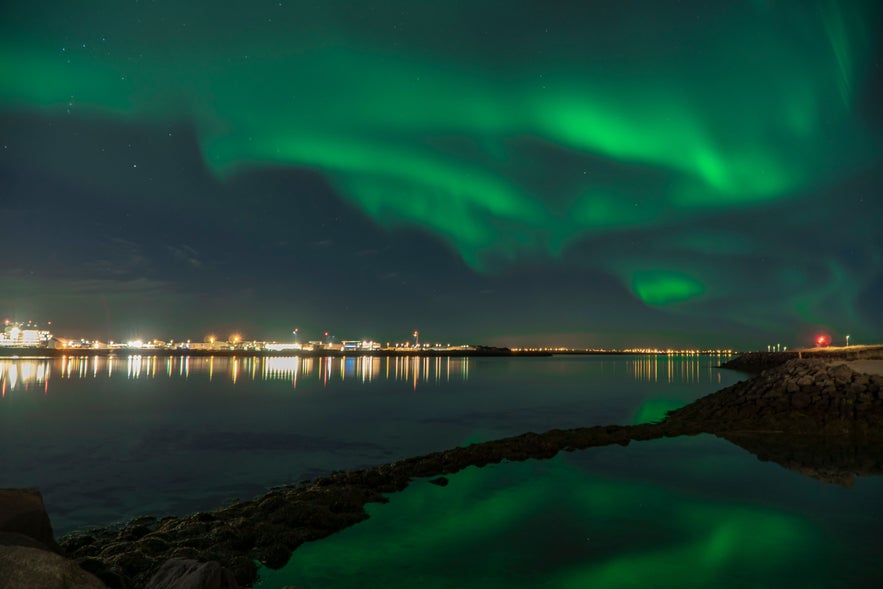 How long they last, what equipment you might need, and more frequently asked questions about the aurora.
How long they last, what equipment you might need, and more frequently asked questions about the aurora.
1. Where is the best place to see the northern lights in Reykjavik?
The best spots in Reykjavik for seeing the northern lights are typically away from city lights. Popular locations include the Grotta Lighthouse, Oskjuhlid Hill (next to Perlan), and the Seltjarnarnes Peninsula. For clearer views, head further out of the city.
2. Can I see the northern lights from the city center of Reykjavik?
It is possible, but the lights may not be as visible because of light pollution from the city. It's better to head to darker areas like the Grotta Lighthouse or the nearby coastlines for a clearer view.
3. What time of night is the best to see the northern lights in Reykjavik?
The best time to see the northern lights is typically between 22:00 and 2:00. However, sightings can occur earlier or later depending on solar activity.
4.Do I need special equipment to see the northern lights?
No special equipment is required to see the northern lights, but a camera with manual settings and a tripod is recommended for capturing the lights.
5. How long does the northern lights show last in Reykjavik?
The northern lights can last a few minutes or several hours, depending on the solar activity. Some nights might have only short bursts of light, while others might have a more prolonged display.
6. What happens if I don’t see the northern lights during my visit to Reykjavik?
The northern lights are a natural phenomenon, so sightings are never guaranteed. However, many tour companies offer a "northern lights chase" with a repeat tour option if the lights don't appear on the first try. For that reason, you may want to book a first attempt early in your vacation so you’ll have the opportunity to take advantage of this option if necessary.
Final Thoughts on Seeing the Northern Lights in Reykjavik
 Hunting for the northern lights in Reykjavik can be an unforgettable adventure. Planning ahead, monitoring forecasts, and venturing to recommended locations can increase your chances of witnessing this elusive dance of lights.
Hunting for the northern lights in Reykjavik can be an unforgettable adventure. Planning ahead, monitoring forecasts, and venturing to recommended locations can increase your chances of witnessing this elusive dance of lights.
Reykjavik offers a variety of settings to enhance your northern lights experience, including iconic landmarks, tranquil parks, and nearby natural wonders.
Remember to dress warmly, bring a tripod for photography, and be patient. Whether you choose the convenience of a guided tour or the excitement of a self-drive adventure, witnessing the northern lights is sure to be a highlight of your memories of Reykjavik.
Are you planning to go northern lights hunting in Iceland? Would you rather embark on a guided tour or go adventuring yourself? Have you witnessed the aurora borealis in all its glory? Share your thoughts in the comments below!

